This is the best, softest, most flavorful Rye Bread you will EVER try, passed down in our family for 3 generations. The recipe is from my husband’s great-grandma Prudy, who was Swedish. Rye bread has a reputation for being heavy and sour, but this recipe is the exact opposite: it is light and fluffy, with an earthy, nutty flavor. There is nothing like it. My mother-in-law makes dozens of loaves every year to give to the neighbors, and we serve it every Christmas Eve with Liver Pate and our traditional Swedish Meatballs.
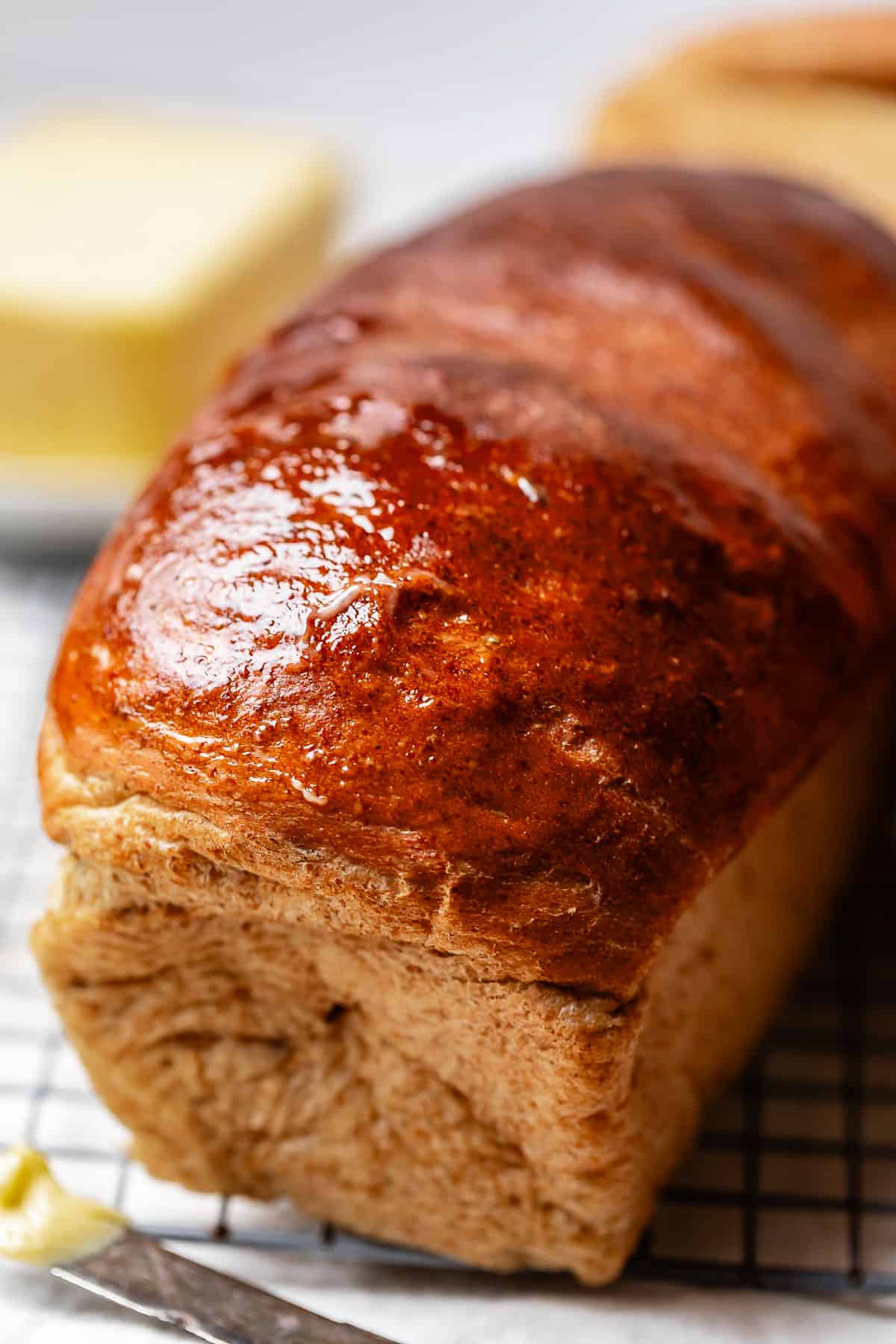
Table of Contents
- Prudence Henrietta Toren Johnson
- What is rye bread?
- When to eat rye bread
- Why this recipe works so well
- Rye bread ingredients
- How to make rye bread
- Rye bread recipe tips
- What to do with homemade rye bread
- How to store leftover rye bread
- Can you freeze rye bread?
- Frequently asked questions
- More delicious bread & roll recipes to try
- Grandma Prudy’s Rye Bread Recipe
When I married into my husband Eric’s family 15 years ago, one of the first things I found out (besides their cutthroat competitiveness over board games, insistence on using cloth napkins at every meal, and obsession with Spritz cookies), was that Swedish Rye Bread is 100% worth the family fights I kept witnessing over who got to eat the last slice.
When they first said Spritz Cookies, Cardamoms, and Butter Pecans, I smiled and nodded. I pictured those pointless cardboard cookies you can buy at the drugstore in little tins at Christmastime. I have since learned the error of my ways. Nothing compares to a freshly baked Swedish cookie.
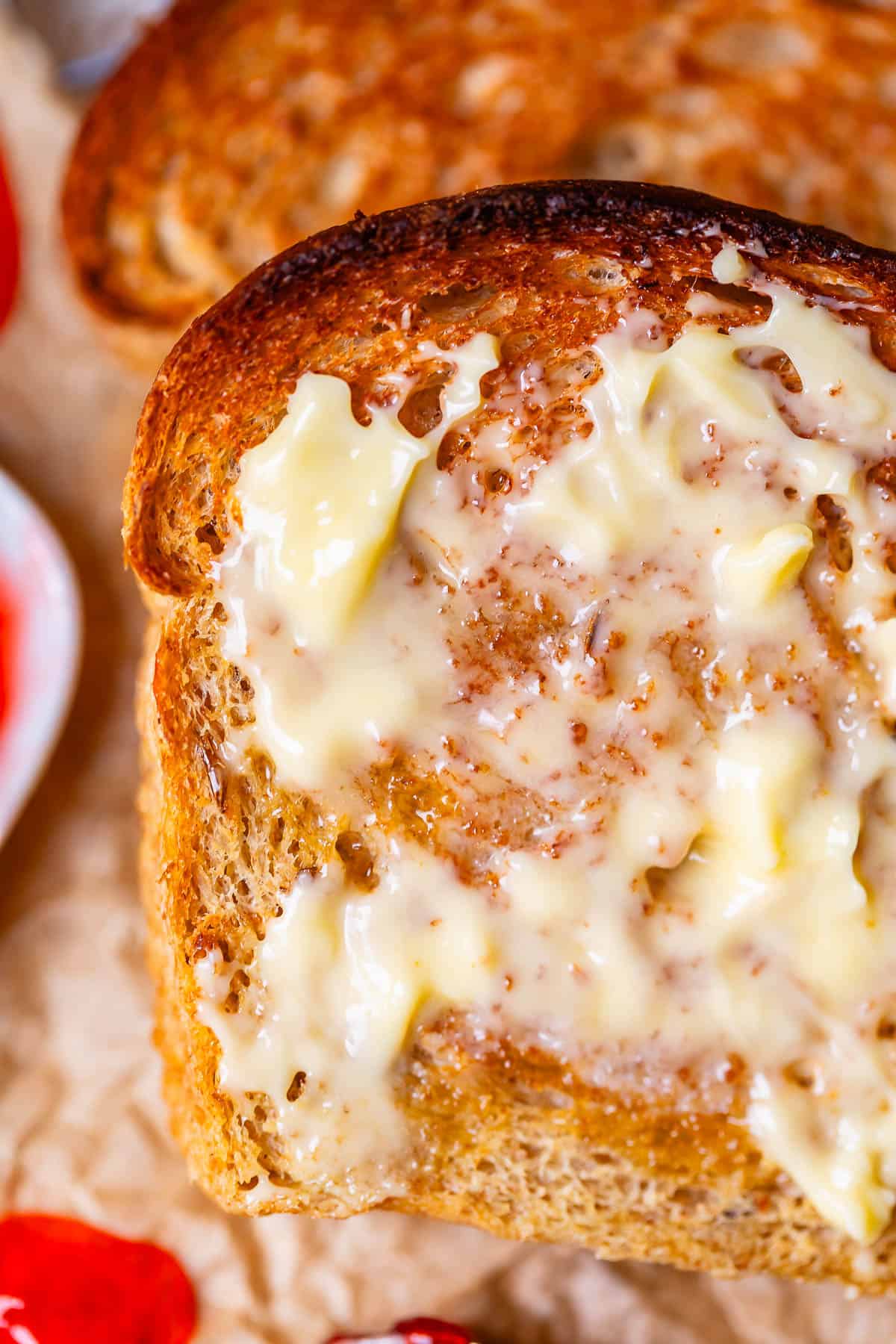
When they first said Rye Bread, I pictured the dark, heavy, swirly-looking bread that is chocolate-dark, like pumpernickel bread. I only knew about Jewish or German style rye bread, made for a sturdy Reuben sandwich. It is not at all like the tiny, fluffy-like-a-cloud slices I could not stop toasting, slathering with butter, and shoving in my mouth on repeat.
I was mystified. What was this magical bread? Homemade bread was not a part of my life growing up. When I left for college, my mom put together a little booklet of easy recipes so I could start making my own simple meals. In the table of contents, there was a section on bread. Here’s what’s on the page:

Needless to say, the bread heritage on my side of the family is a little underwhelming. (Except aunt Shirley, she’s really is the queen. She gave the world these Homemade Dinner Rolls.) One of the best parts about getting married is doubling your family, and I’ve made it my life’s mission to master all the old Swedish recipes Eric’s family loves so much.
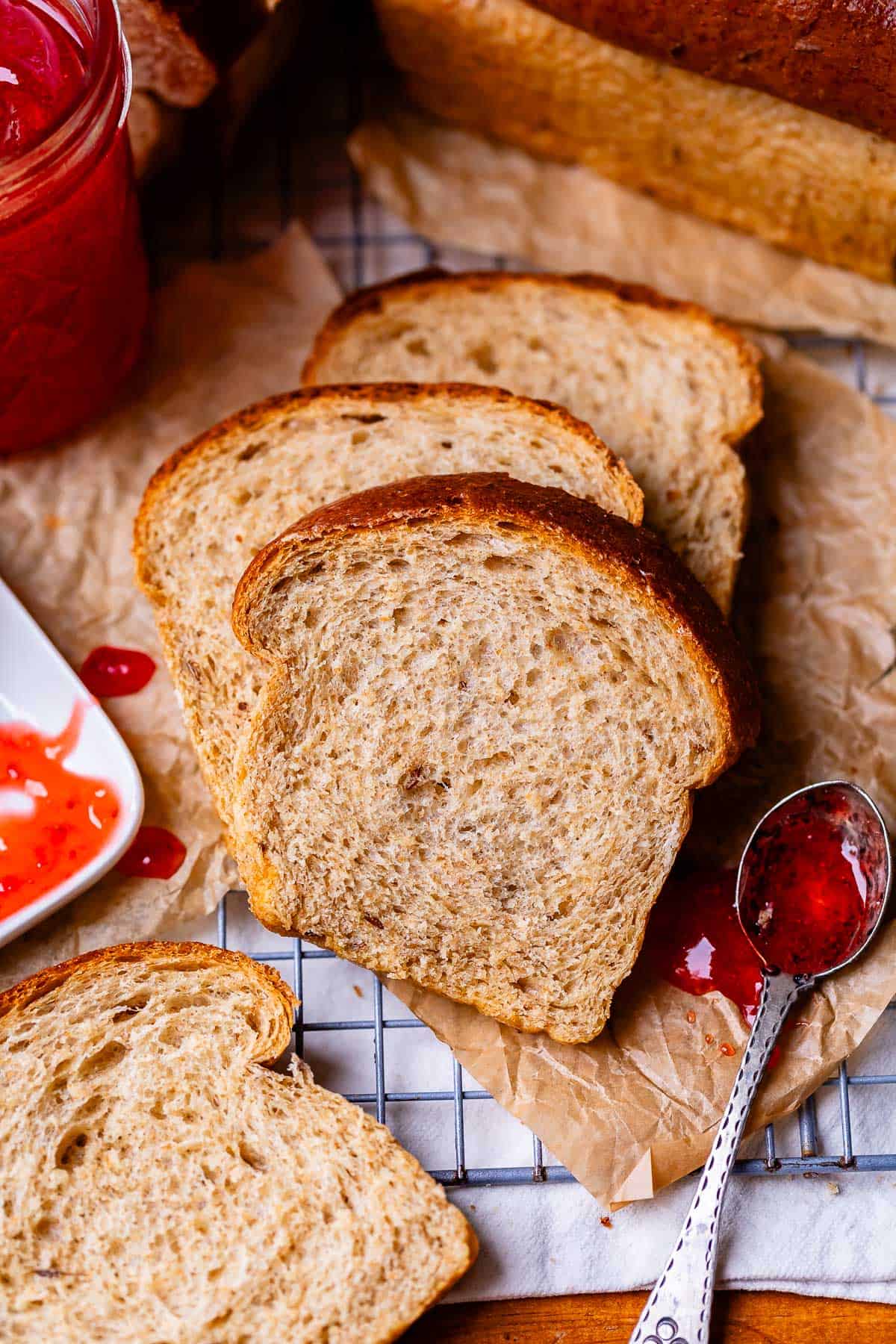
Prudence Henrietta Toren Johnson
The famous family rye bread recipe is from Prudence Henrietta Toren, Eric’s mother’s grandma. Prudy was born in 1898 to Swedish immigrant parents living in Minnesota. She was a tiny lady, topping out at 4’11, and graduated from college, pretty rare for her generation. She passed away long before I was on the scene, so I never got to meet her. She was a fantastic cook and made traditional Swedish recipes from her family. Her grandkids even made an official printed book of all her Swedish recipes.
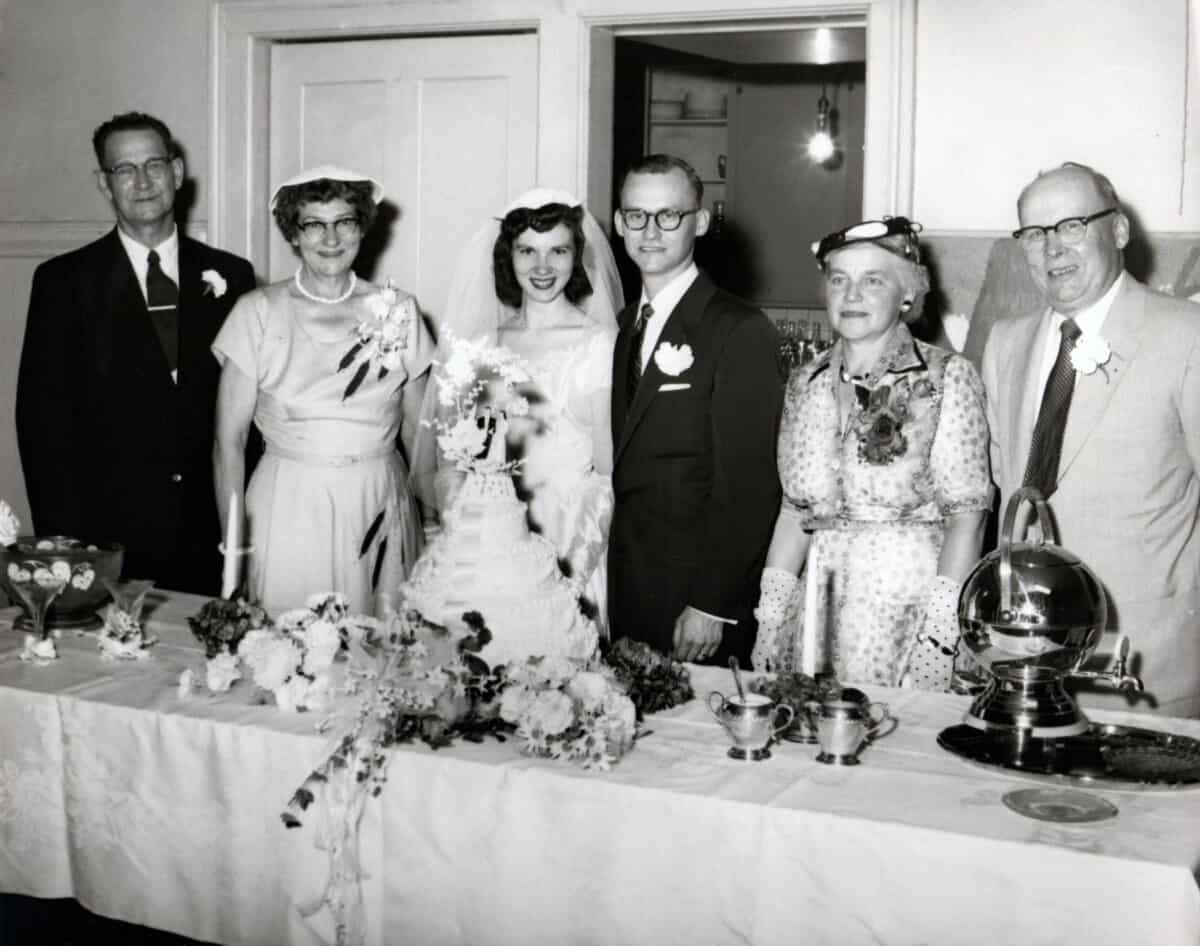
Here is Prudy, on the right with her husband Carl, at their son’s wedding (Eric’s grandpa) in 1955.
Eric’s mom Kris remembers Prudy making rye bread every year at Christmas back in the 50s and 60s. Prudy’s recipe was a double batch of what is on today’s recipe card (I halved the amount to be able to fit in a regular stand mixer.) Her recipe made 8 small loaves of bread. She would bake, kneading every batch by hand, until she had around 50 loaves, and then would deliver them as gifts to all the neighbors and all the employees at their family hardware store, along with plates stacked high with dozens of Swedish cookies.
A legend, right? Honestly, this is the kind of community-building I aspire to. I can’t wait to meet Prudy one day!
What is rye bread?
Let’s talk rye. This recipe, as I mentioned, does not make the heavy, tangy, sturdy loaves you are likely to see in a Jewish bakery. Instead, it makes appetizer-sized loaves of pillow-soft and mildly sweet bread that you can eat half a loaf of by yourself before you even know what happened.

I asked the family for a description of rye bread:
“That’s hard to do…it’s nuttier. Somehow it seems seedier. It’s kind of like whole wheat, without it being whole wheat if that makes sense?”
It is indeed the color of whole wheat bread, but it is much lighter and softer than whole wheat bread. It is not dense, at all. It is soft as a cloud, yet somehow chewy and hearty, with a nutty, earthy flavor. It is more complex and flavorful than regular white bread. It honestly is kind of hard to describe. When was the last time you ate anything with rye flour in it? It’s just unique. The bread has caraway seeds in it, which I absolutely love, but you can leave them out if you don’t like caraway.
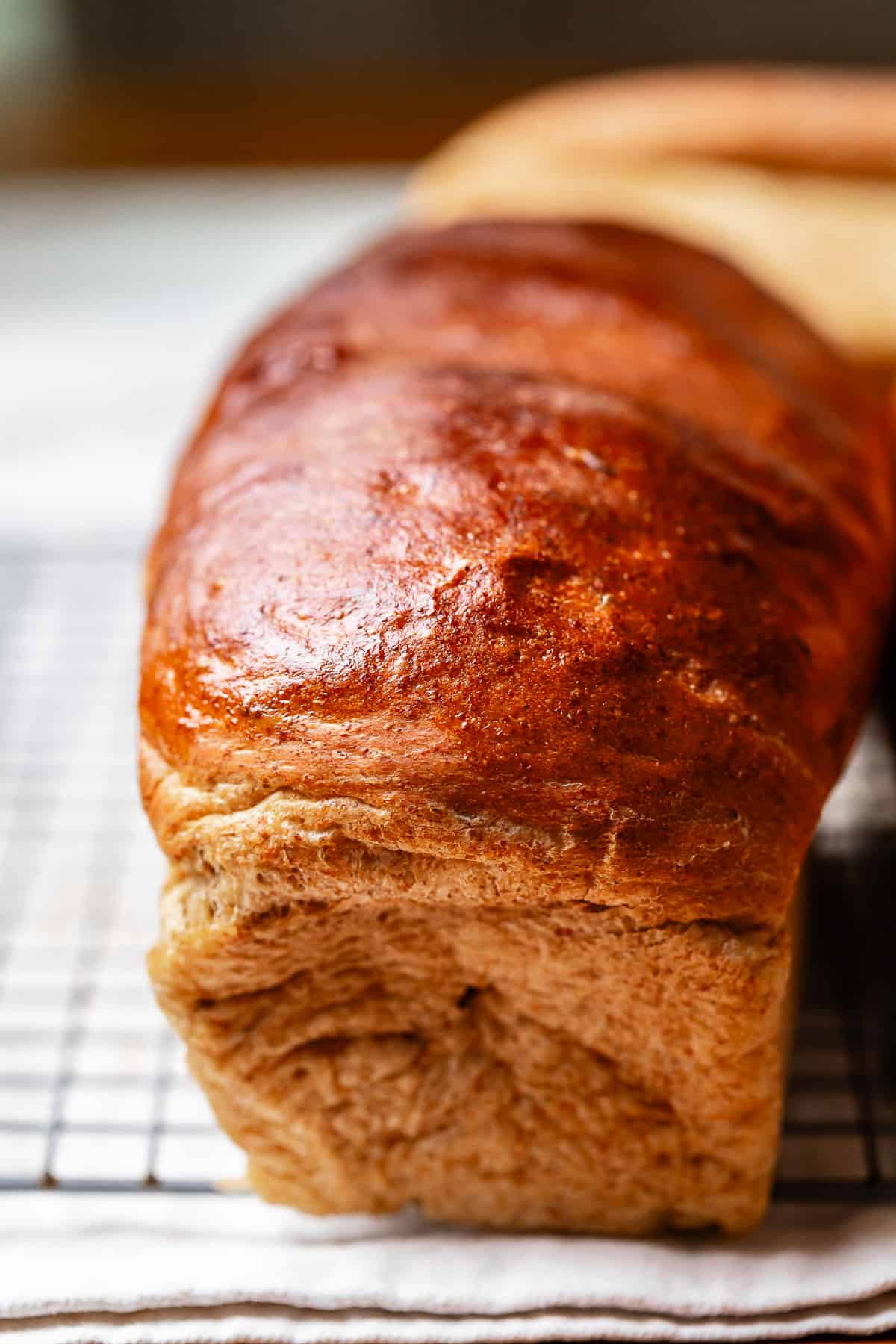
I sent this photo to my beloved business coach Jadah Sellner. She said, “That bread looks amazing!! It looks like Brioche.” She nailed it, it really is as soft as brioche!
When to eat rye bread
This rye bread is meant to be served as a snack or appetizer, so it is baked in a much smaller pan than the normal 9×5 we are used to. The tiny loaves it makes are adorable. You will just want to pop the whole thing in your mouth. Prudy’s 70-year old pans, featured in the photos (Kris brought them from Montana so we could photograph the bread in them), measure about 7×4 inches. I give details in the recipe for the normal 9×5 loaf pan size though, don’t stress.
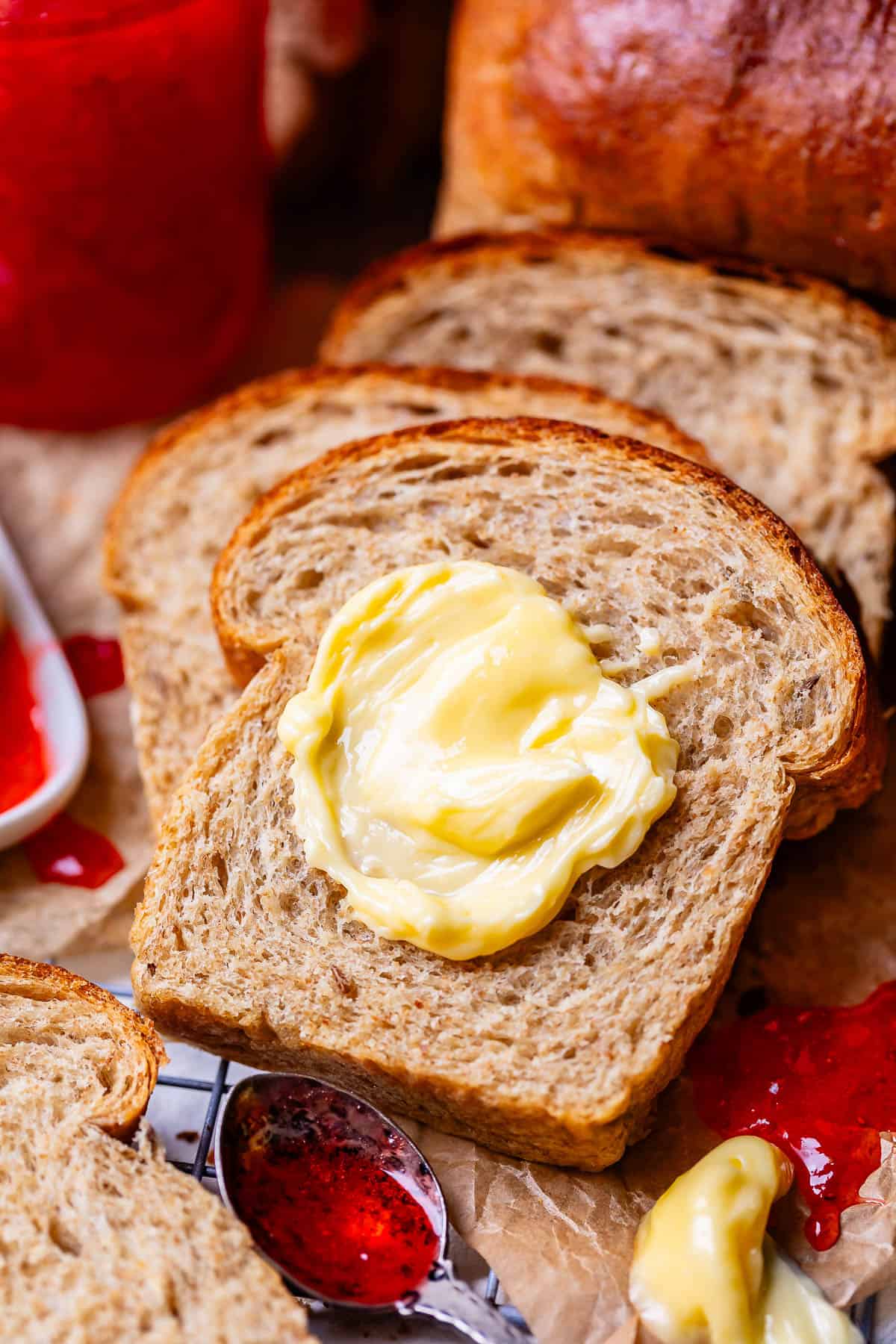
We don’t usually eat rye as a sandwich bread (although it really would be delicious on a Reuben). Instead, the tiny loaves are sliced and served as an appetizer at Christmastime with Liver Pate, or just toasted with butter and a side of cheese. (Nothing feels more “Eric’s-family” than this snack. I’ve seen his dad wake up at midnight from a pre-bedtime slumber on the couch, only to shuffle off to the kitchen for a butter-on-rye-toast and cold Muenster cheese snack.
Technically rye is a savory bread, but that doesn’t stop Eric and I from slathering it with jam every chance we get. Kris thinks this is weird with the caraway, but maybe I’m just a little obsessed with jam, okay? I say it’s good any way you slice it. See below for more ideas on what to serve with rye bread.
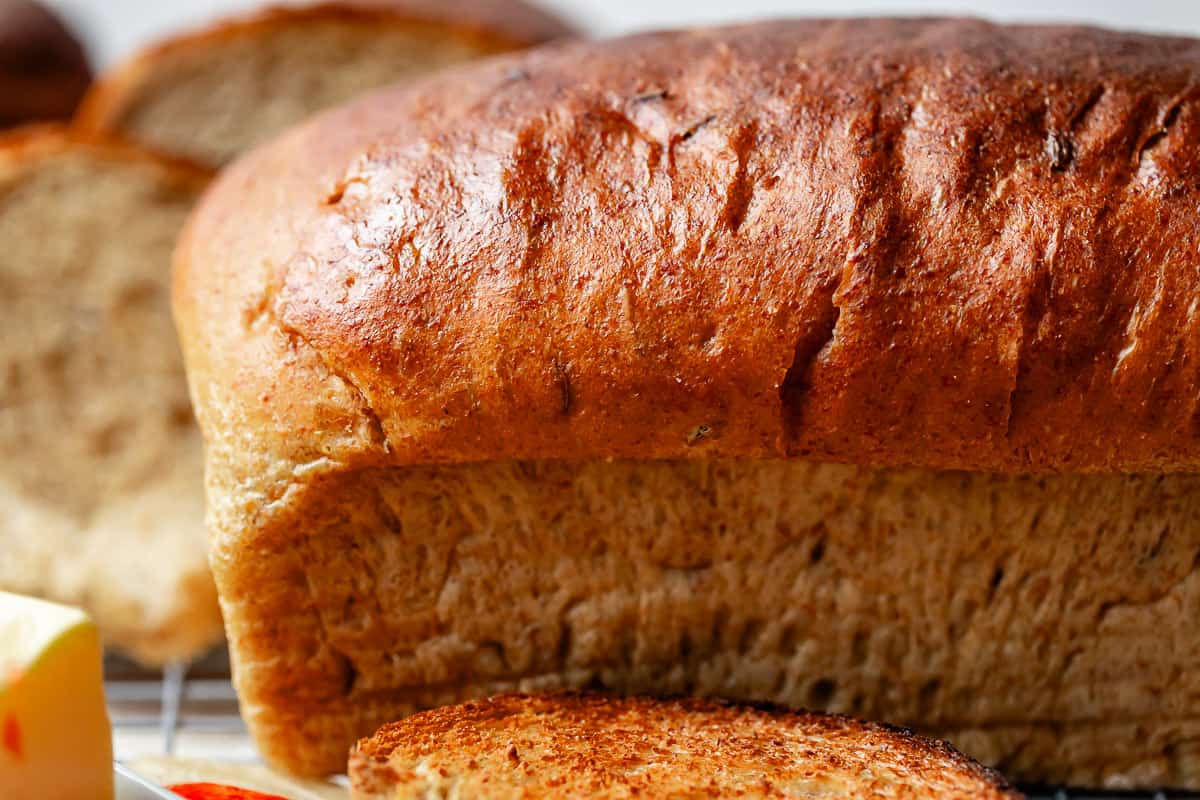
Why this recipe works so well
Kris has been perfecting her grandma’s recipe for years, to work even better for the modern cook. There are a few secrets to success that actually make the difference between a dense, heavy loaf, and a light, springy one.
- Triple rise. Most breads call for one rise in the bowl, then shaping into loaves to rise again, then baking. This rye bread recipe calls for TWO rises in the bowl before shaping the bread, one hour each, and then a third rise in the pans. This is annoying, yes, but not really optional. Rye flour is very low in gluten, meaning it does not rise as well as breads made with wheat flour. We make up for it in time and another special ingredient:
- Vital Wheat Gluten. This added protein helps make up for the lack of gluten in rye flour mentioned above. I’m obsessed with vital wheat gluten and add it to ALL my breads, even ones with all wheat flour, like this Homemade White Bread recipe. It provides structure in your dough, providing a nice home for the gas emitted from the yeast to live; this CO2 hanging out in between bread proteins is what makes your bread puff up.
- Not adding too much flour. This dough is not the same as regular wheat bread dough. It is way more sticky. With most bread recipes you need to add flour until the dough is no longer sticky, until it’s workable and you can handle it easily. Rye bread is different. If you add enough flour that it’s not sticky, you will get a dense, heavy loaf every time. We don’t even shape the bread on a floured surface, we use an oiled workspace instead.
- Molasses gives the best robust flavor and is a classic sweetener in rye bread
- Shortening makes the bread super soft. You can replace it with butter, but it won’t make your bread quite as pillow soft as shortening.
- Kosher salt. I add at least 2 teaspoons. Salt acts as a magnifier for the other flavors in the bread (and indeed, in anything.) If you only have table salt, add 1 and 3/4 teaspoons. In her later years, Grandma Prudy’s doctor told her to reduce her sodium intake, and Prudy was not messing around. She eliminated ALL salt from ALL of her recipes. Kris talks all the time about how nothing was the same after that 😂 I promise, the salt you add to your baked goods is not your sodium problem.
Rye bread ingredients
This is just a quick look at the ingredients you need. Scroll down to the recipe box below for exact amounts and full instructions!
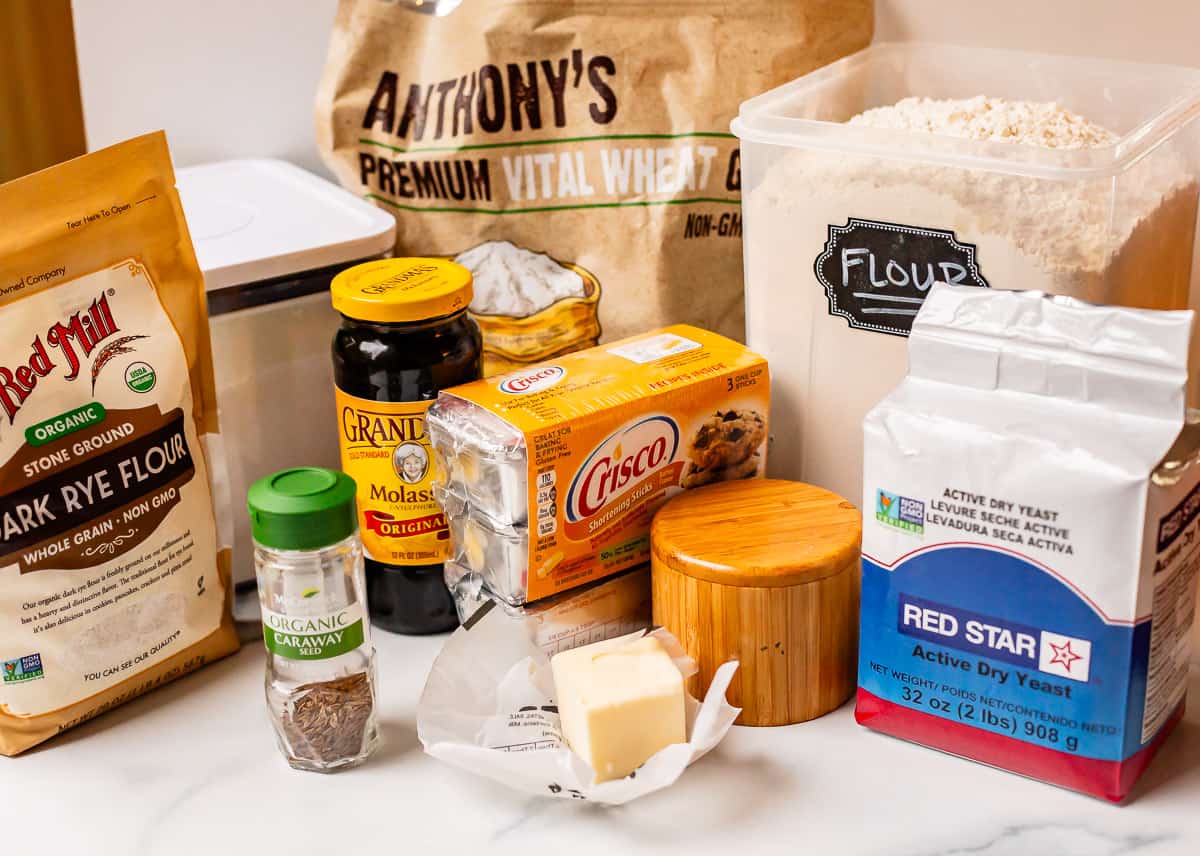
- active dry yeast
- water
- granulated sugar
- molasses
- shortening
- kosher salt
- caraway seed, optional
- vital wheat gluten flour
- light or dark rye flour
- all purpose flour
- vegetable oil
- butter
How to make rye bread
This ain’t no sourdough recipe, we are starting off with some good ol fashioned yeast. Add about a tablespoon to some warm water in your mixing bowl. You want the water to be warm but not hot, about the temperature of a baby’s bath. (If you wouldn’t dump this water on a baby’s face right now, then it’s too hot.) Treat your yeast like the baby that it is!
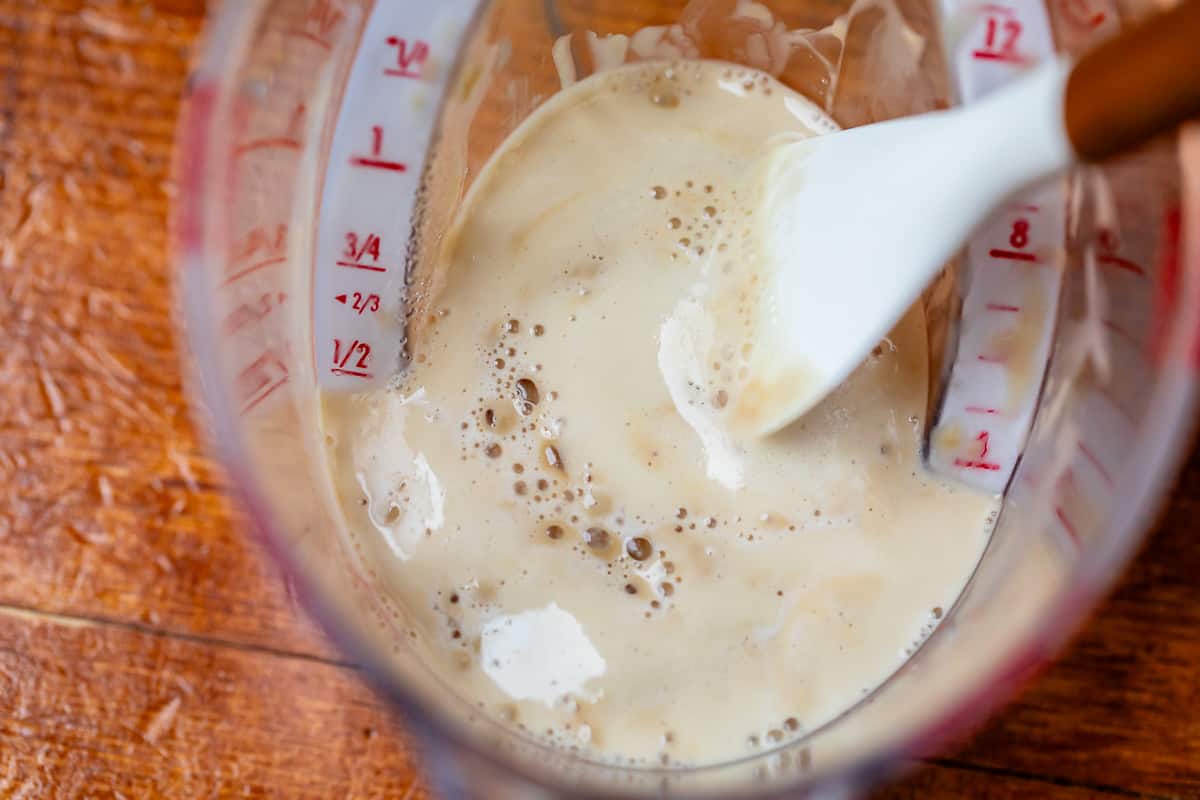
Once you see bubbles coming up out of your yeast mixture, you know it’s alive and well. If there are no bubbles, ya done killed it, dump it and start over. Tasteful infanticide joke here? Nah
Now it’s time to add in that classic rye bread flavor:
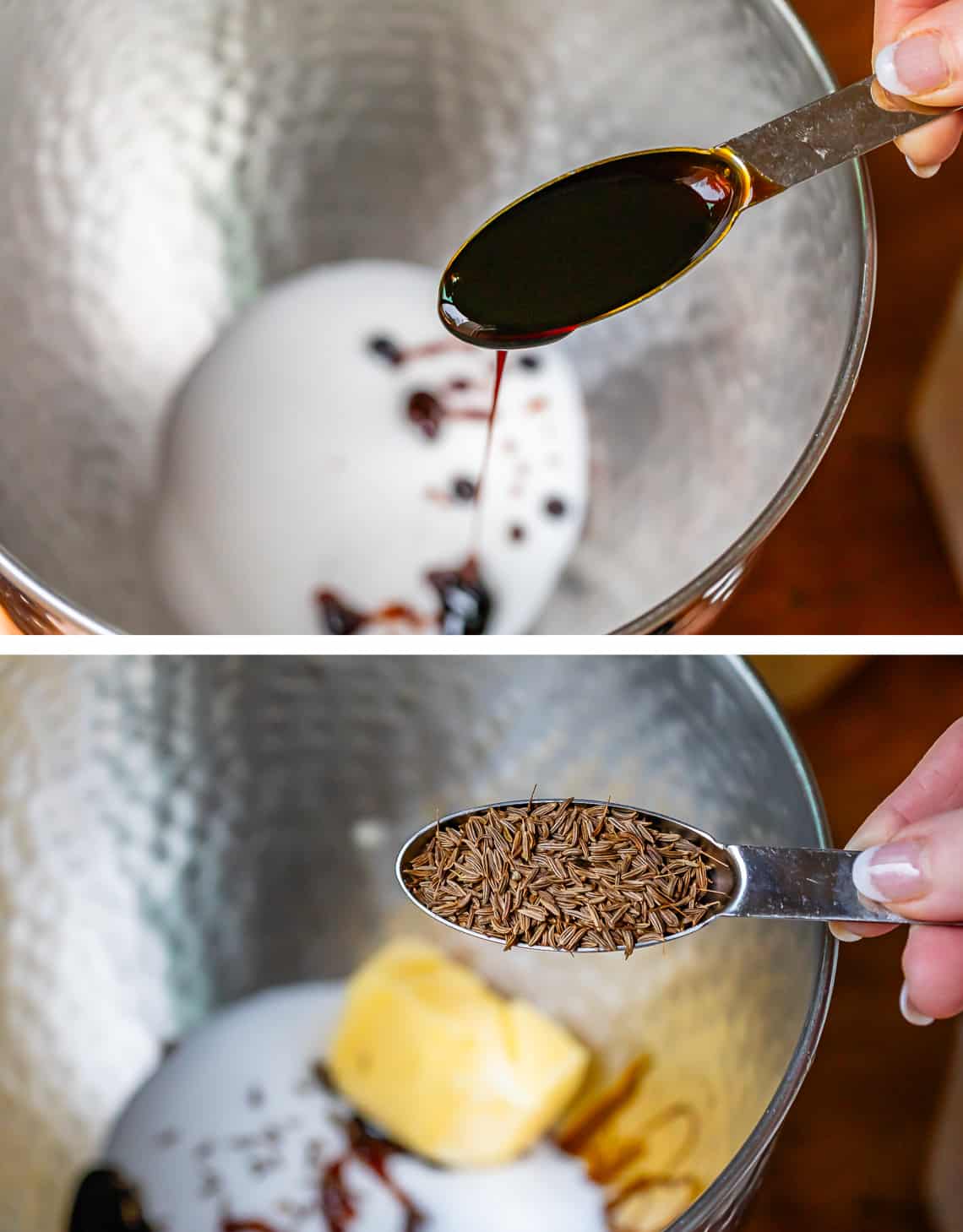
Molasses adds a deep, complex sweetness, and caraway seed intensifies rye flour’s already earthy, bright, and slightly bittersweet flavor. Have you used caraway before? So delicious.
We’re also adding in more water, sugar, shortening, and salt. Scroll down to the recipe for all the details! I just want to show you pictures of the important parts so you can see the technique.
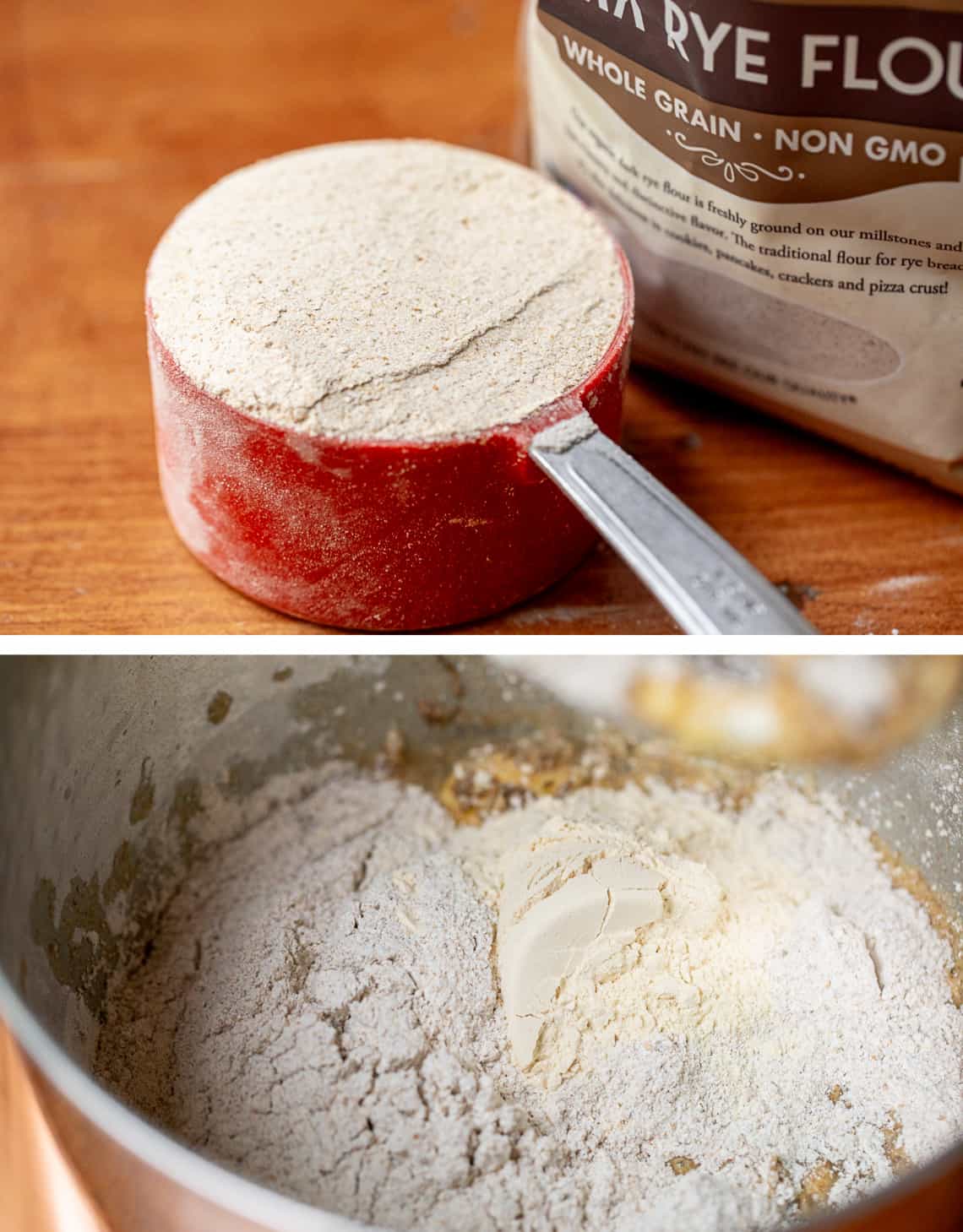
Here is what rye flour looks like. It’s a little more grainy, it’s not as fine as all purpose white flour. Flavor you can SEE! Someone on the Grains Council should hire me to advertise for them.
Add in your rye flour, vital wheat gluten, and 3 cups of the all purpose flour, don’t add in that last 1/2 cup! Be sure to spoon and level your flour. That means use a spoon to add the flour to the measuring cup, then level off the top.
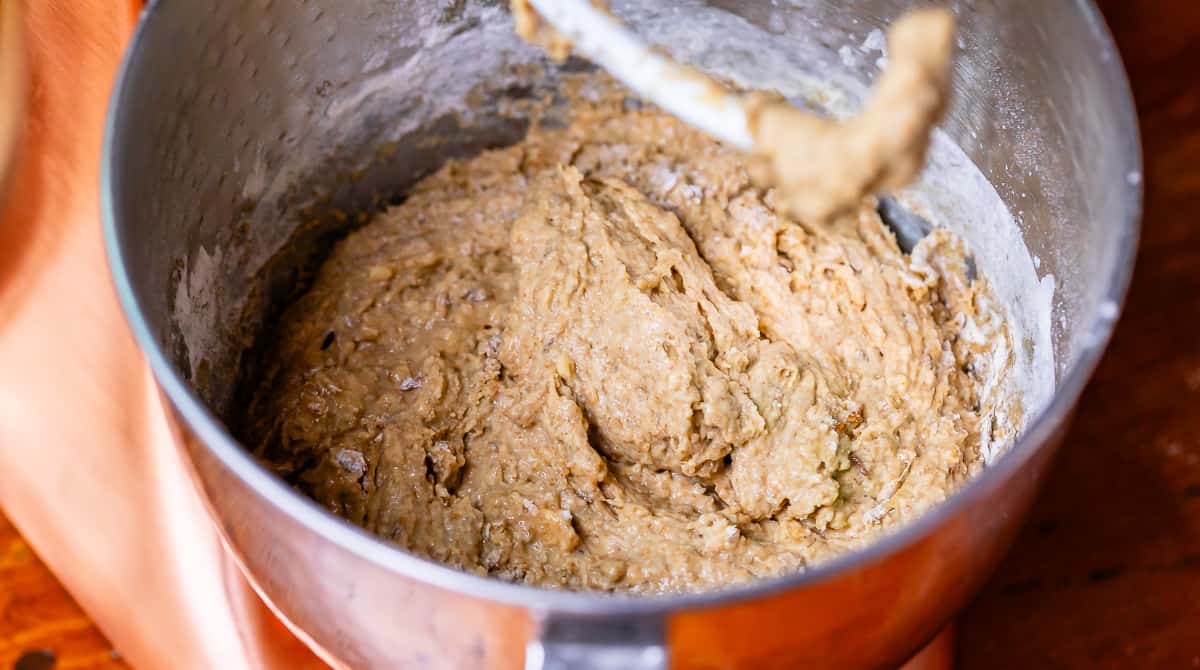
Stir it up until it looks wet and sticky like this. DO NOT be tempted to add more flour right now! It is supposed to be wet and sticky. It is not like normal bread dough. If you haven’t been using the dough hook, make the switch now.
It’s time to get kneading. You want to keep this dough moving for a solid 5-8 minutes. Kneading dough causes the two proteins in wheat flour to combine, making gluten. Gluten acts like a ladder or web, trapping the carbon dioxide emitted from developing yeast, pushing your bread up. Science! One more fun fact: wheat flour has about 3x the amount of gluten as rye flour. This is why we have to combine flours! Rye flour by itself just won’t rise as high.
(If you are kneading this by hand, use the least amount of flour you possibly can! Knead on an oiled surface rather than a floured one.)
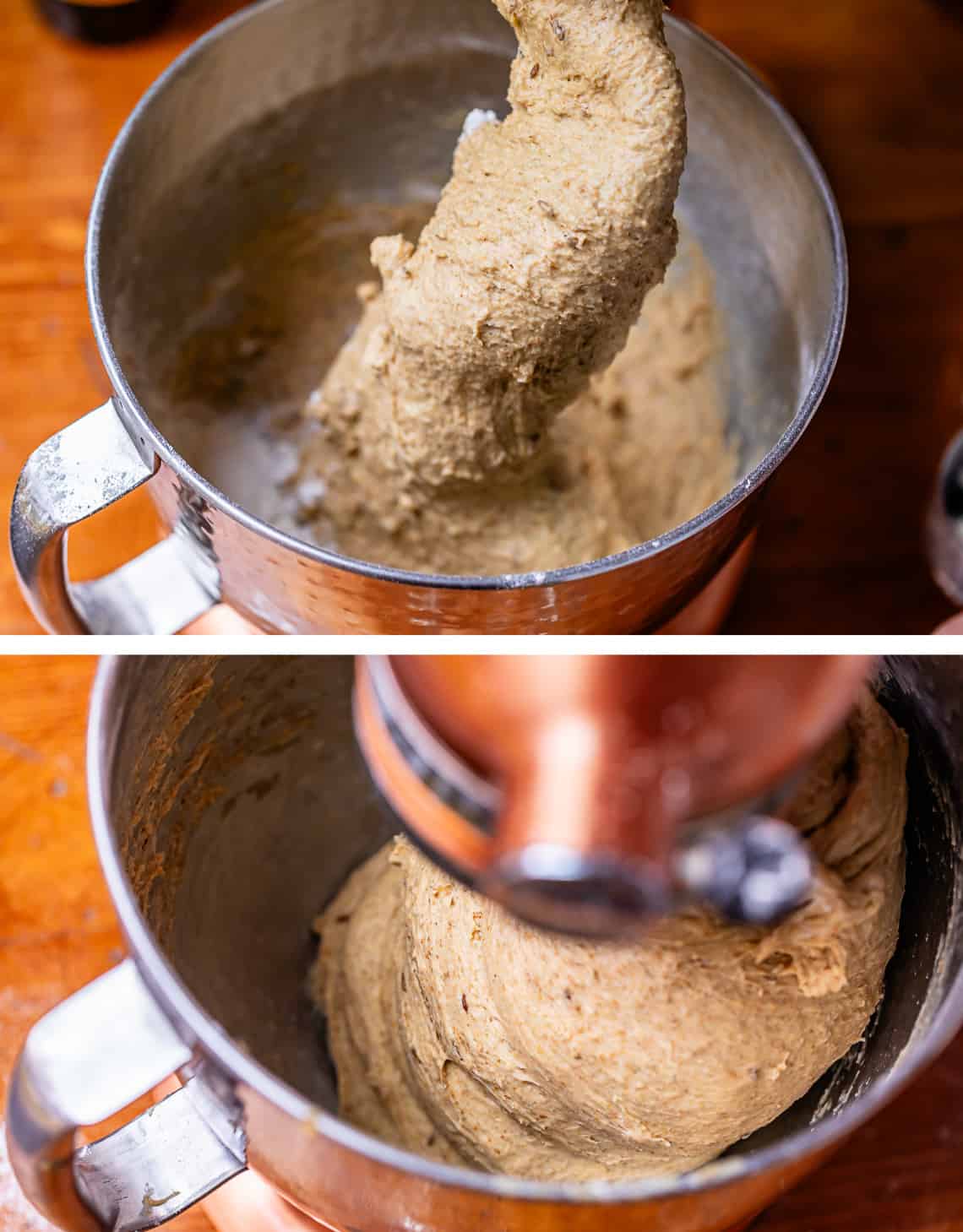
As the dough is kneading, measure out your final 1/2 cup of all purpose flour. Add it to the dough a shake or two at a time, with the mixer on, until it is all added in.
Once all the flour is added in, and it’s been kneading a few minutes, your dough should be kind-of-almost cleaning the sides of the bowl (not the bottom). If it still looks sticky all the way up to the top, add in a couple more tablespoons of flour. But DON’T overdo it! I’m telling you, this is the moment that will make or break your bread, so don’t go crazy with the flour.
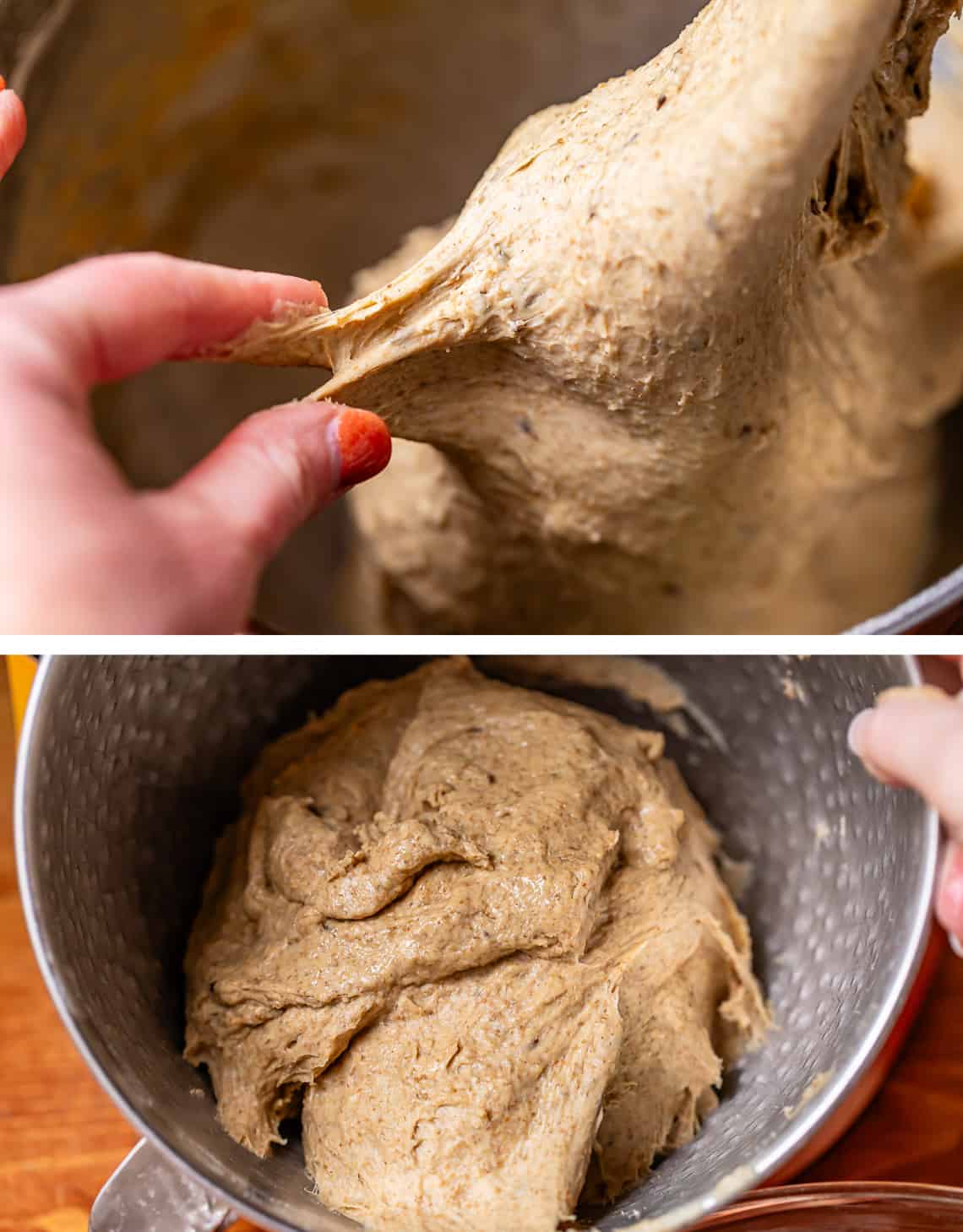
This is the final dough, after it’s been kneaded and all the flour has been added. It will stick to your fingers. It is mostly coming together, but is not quite a solid ball of dough.
Next oil a clean bowl with a lot of oil, like a full tablespoon. Use your fingers to spread the oil around. We do not want this dough drying out, and we don’t want to add ANY more flour. It’s oil or bust from here on out.
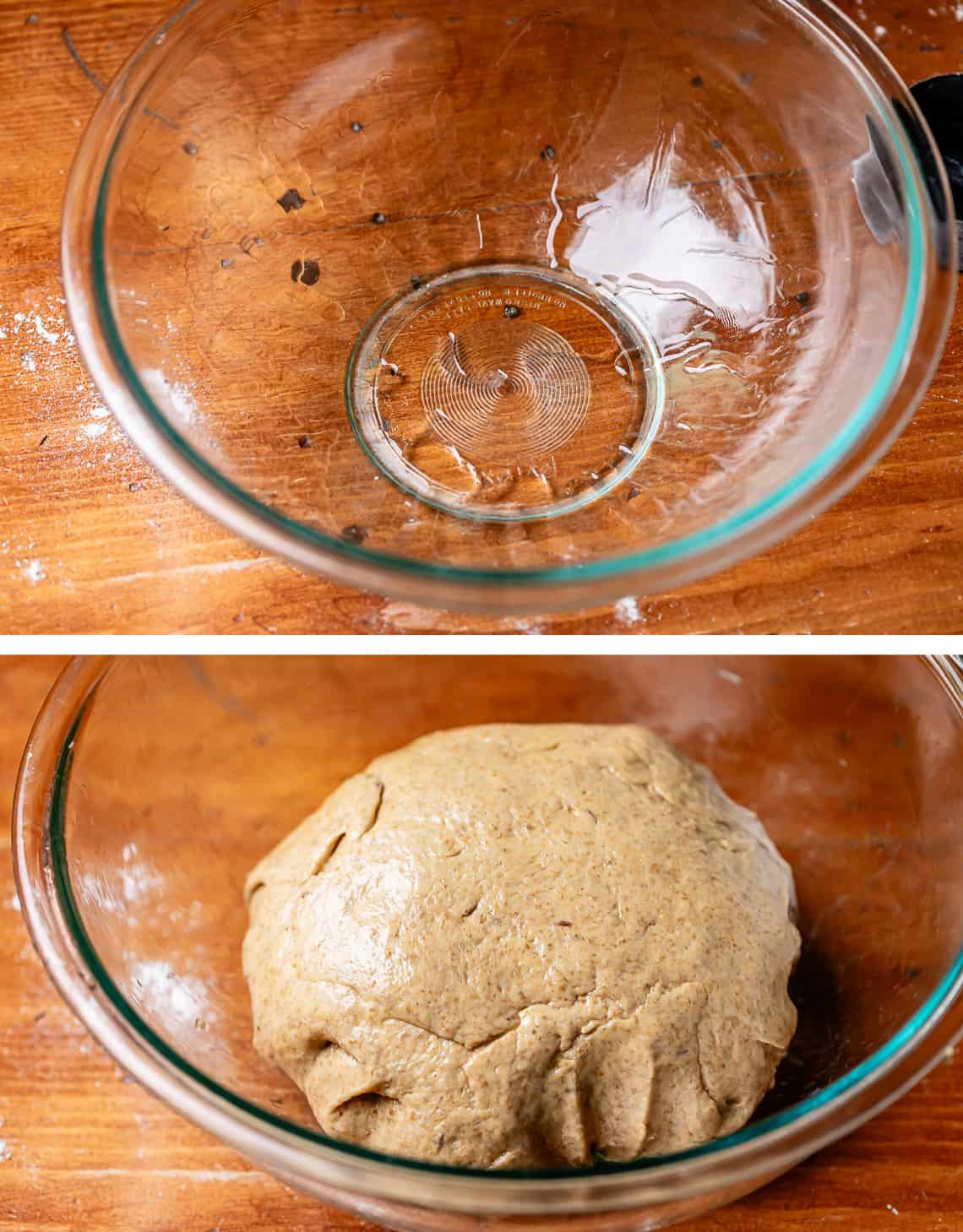
Use your oiled fingers to transfer the dough into the bowl. Shape it into a nice ball, then turn it over so that it’s completely coated with oil.
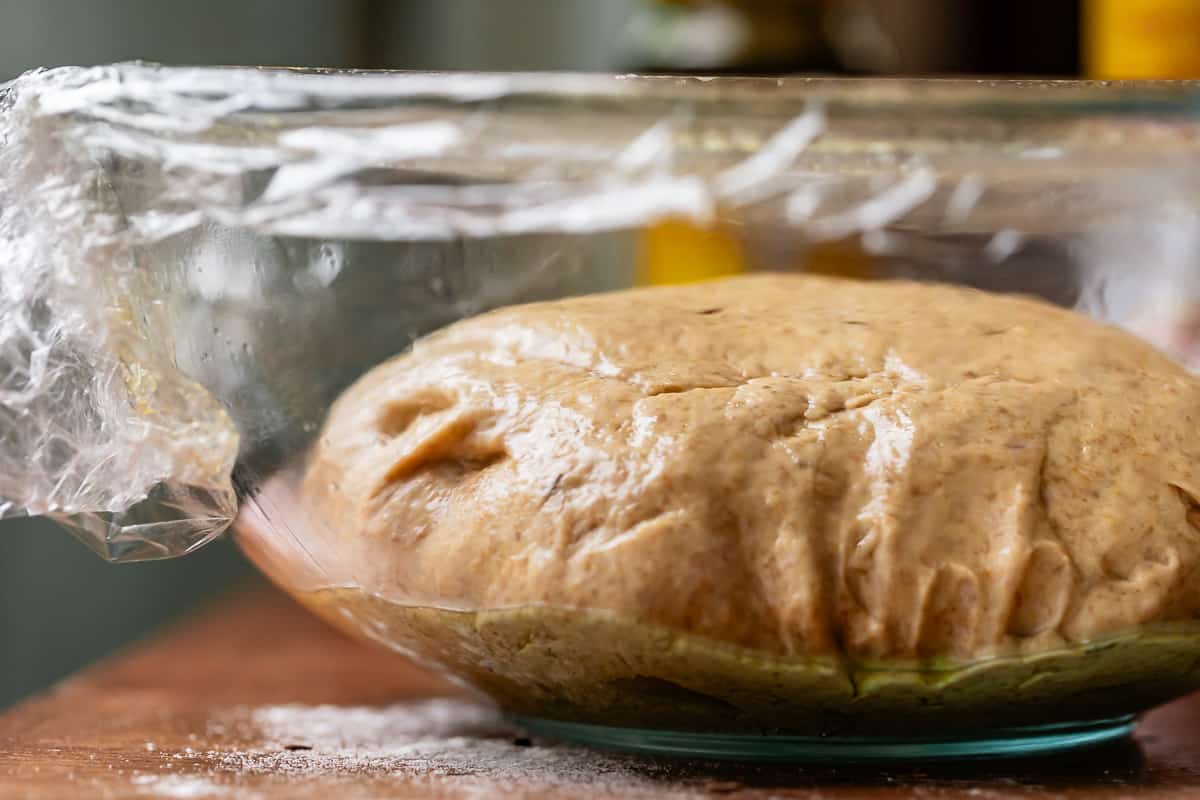
Spray some plastic wrap with nonstick spray and loosely cover the bread. Let the dough rise in a warm place for 1 hour.
I like to turn my oven on to 350 for about 45 seconds, then turn it off. You don’t want a hot oven, just warm. If you can’t touch the racks with your fingers, it’s too hot (leave the oven door open until it’s cooled a bit.) I can’t tell you how many times I have turned my oven on “just for a second” to rise some dough and ended up with a fully hot oven, so set a timer if you’re a doofus like me.
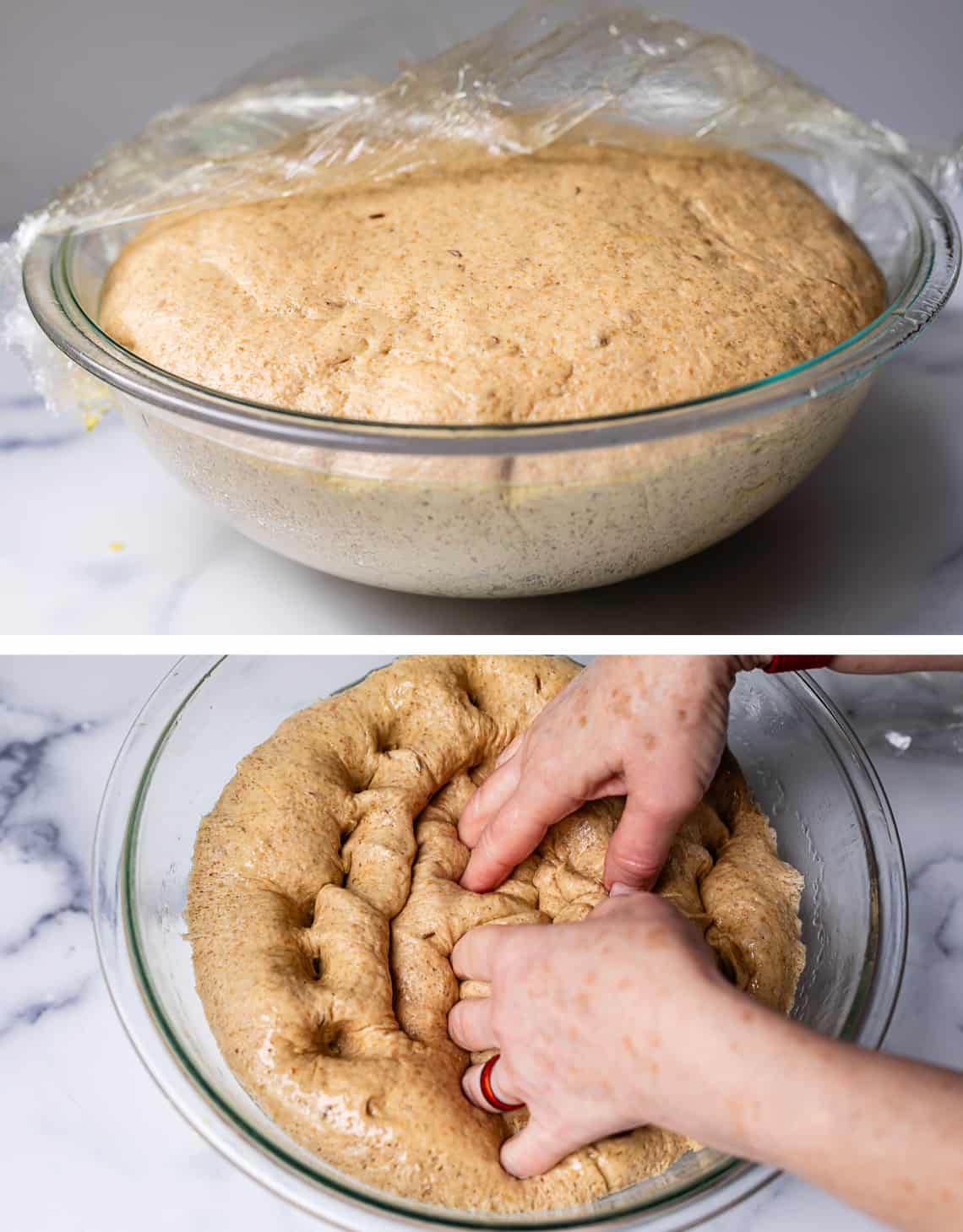
Here she is after the first rise. Beautiful! Now punch it down, reshape, and do it all again; grease the bowl again, rewarm your oven and everything. You really can’t skip this.
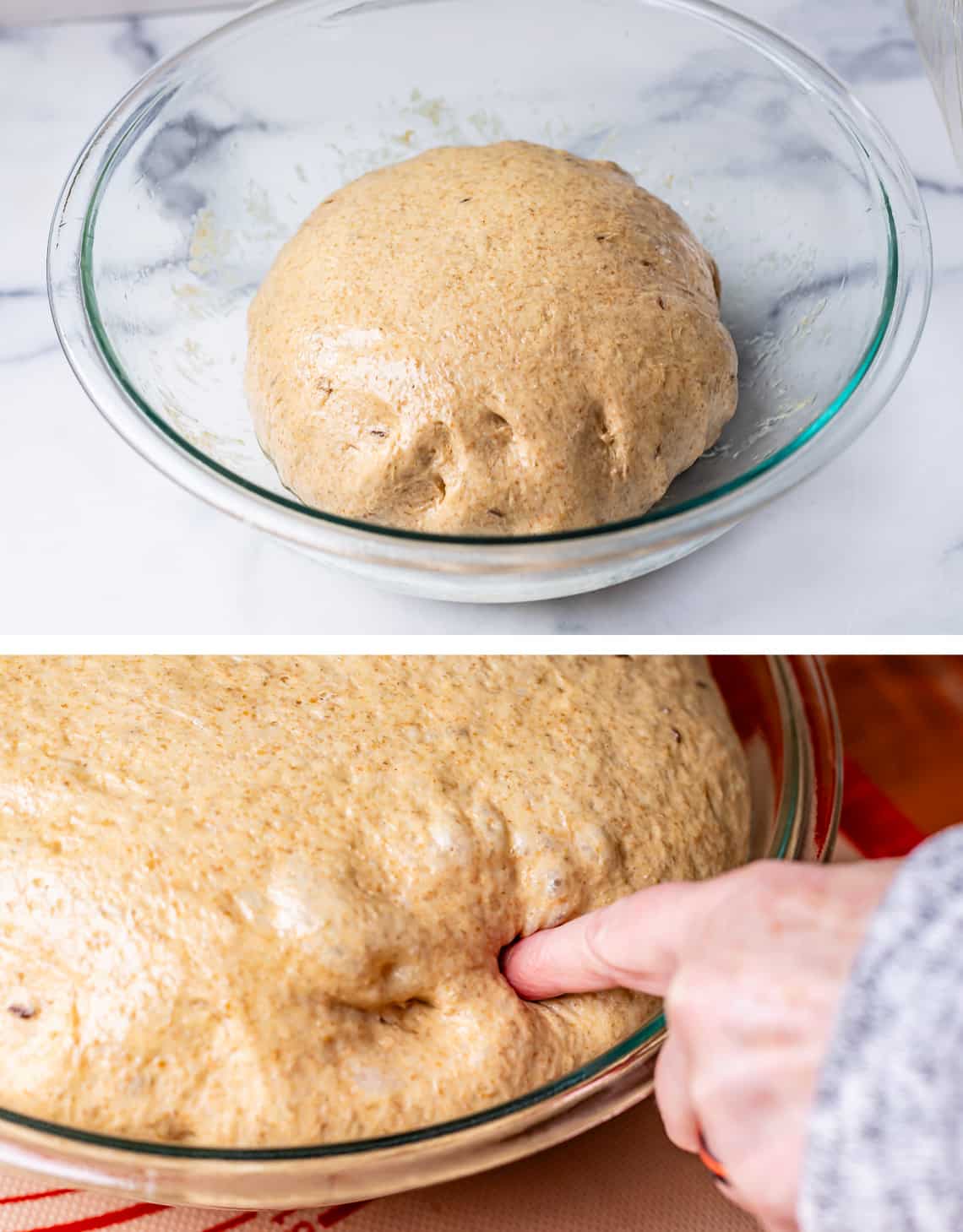
After the second rise, you should be able to poke your finger in the dough and leave an indentation. The dough should not spring back immediately.
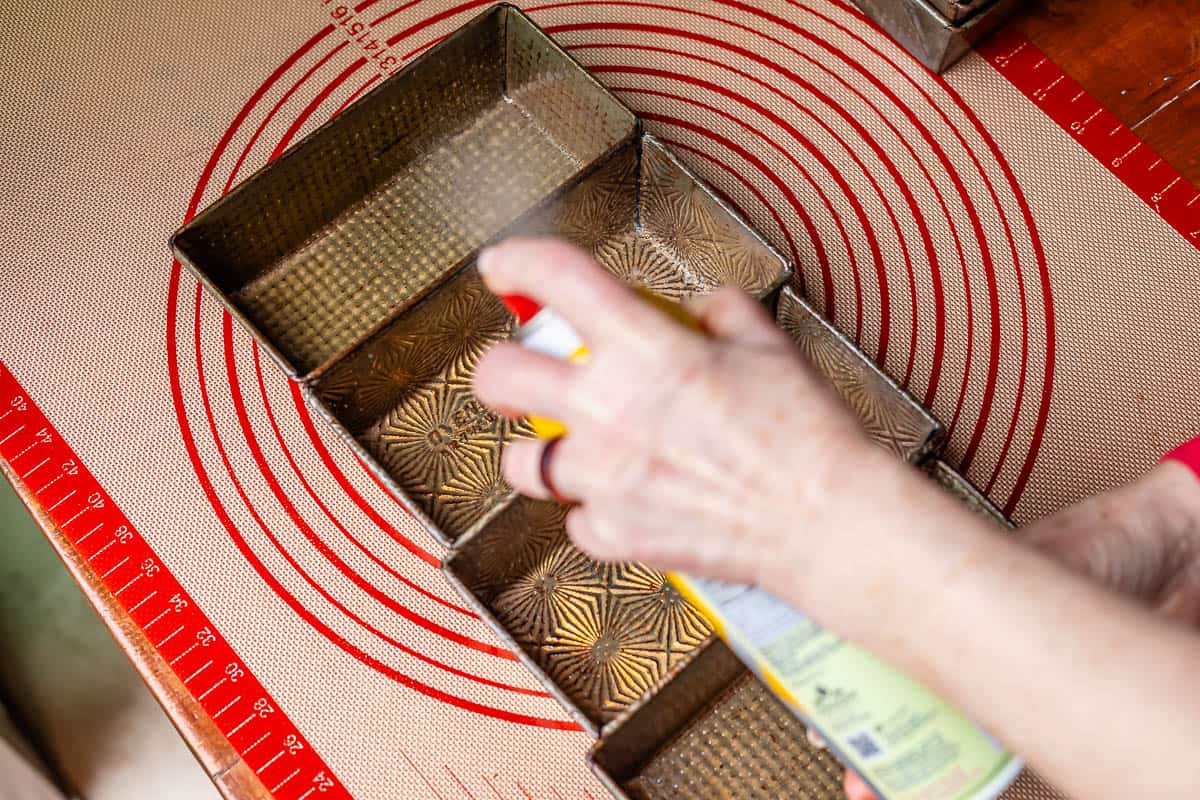
Spray your pans generously with nonstick spray. We are using Prudy’s 7×4 inch pans, which makes 4 loaves. There are notes in the recipe card about using 9×5 inch pans. This will make two larger loaves, better for sandwiches.
Lay out a silicone mat on your work surface and drizzle with a tablespoon or so of oil. If you don’t have any silicone, drizzle oil directly on a flat non porous counter top. Spread it around with your hands.
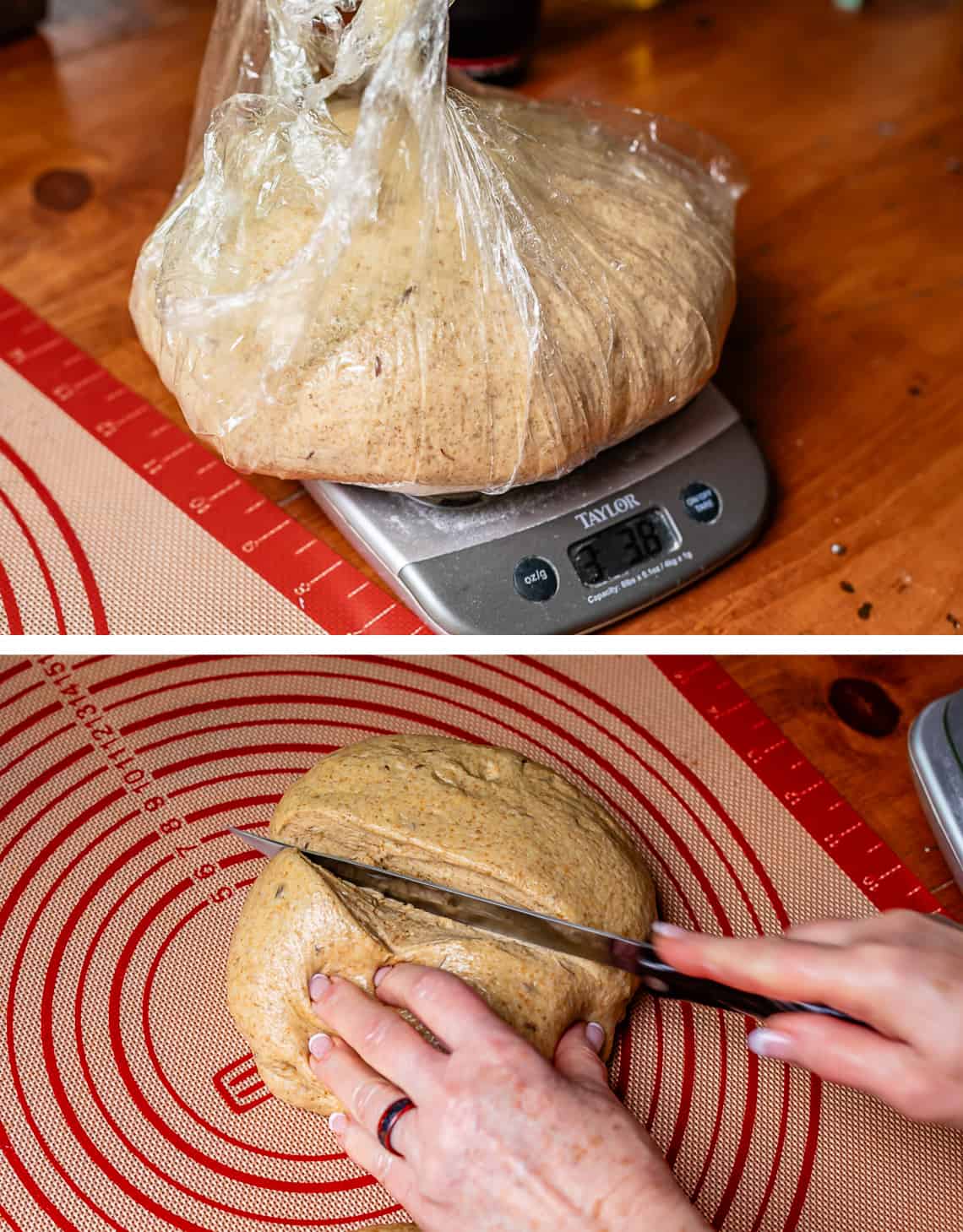
Kris always weighs her dough to make sure the loaves are equal, but if you don’t have a scale you can just eyeball it. You need to split the dough into 4 pieces for 7×4 inch pans, or just in half for 9×5 or 8×4 inch pans.
Press the first portion of dough into a rectangle. The dough should be soft and pliable, and you hopefully won’t need a rolling pin. Can you see Kris’ finger marks all over the dough? She just patted it down. You want to make sure the rectangle is about the length of your bread pan, whatever size it is.
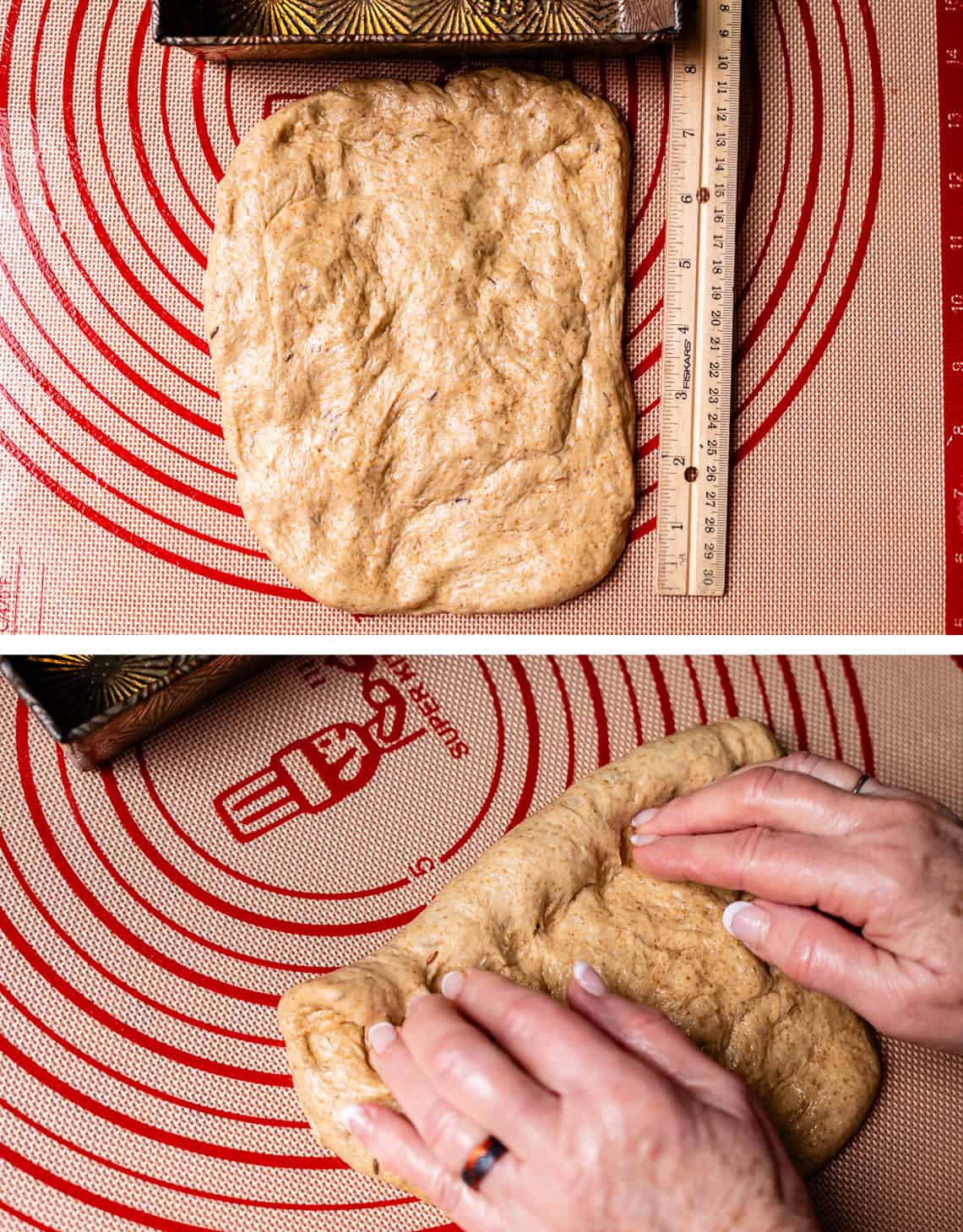
Take the end of the dough that is about the length of your pan and start to roll-pinch it up. This is a very technical term, meaning that you roll and then lightly pinch, and I just made it up. But you get the idea right?
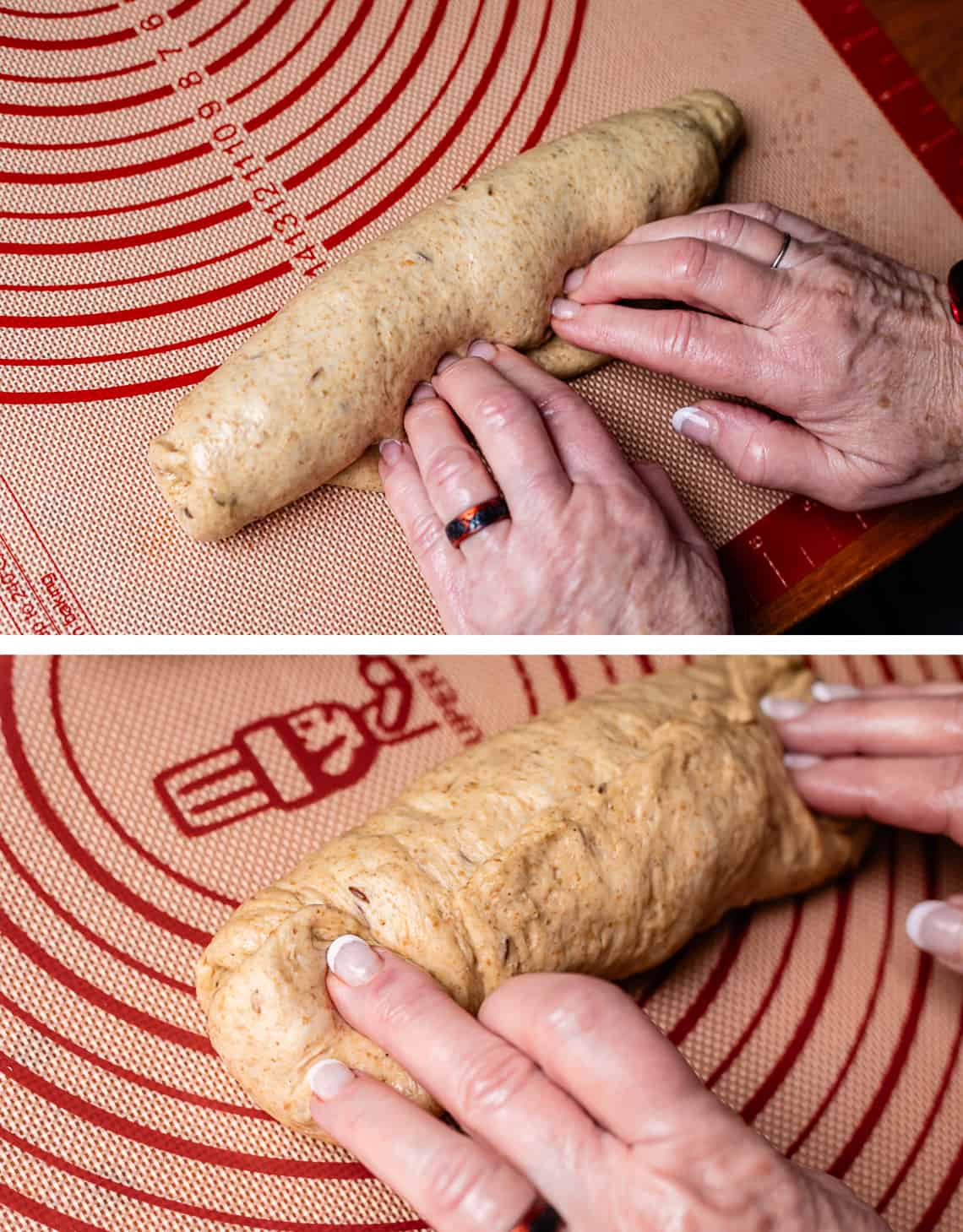
Tuck the ends of the loaf underneath where the seam is, and smooth your baby burrito bread into itself a bit. Lift it gently and place seam side down in the well-greased pan. Cover well and let rise again.
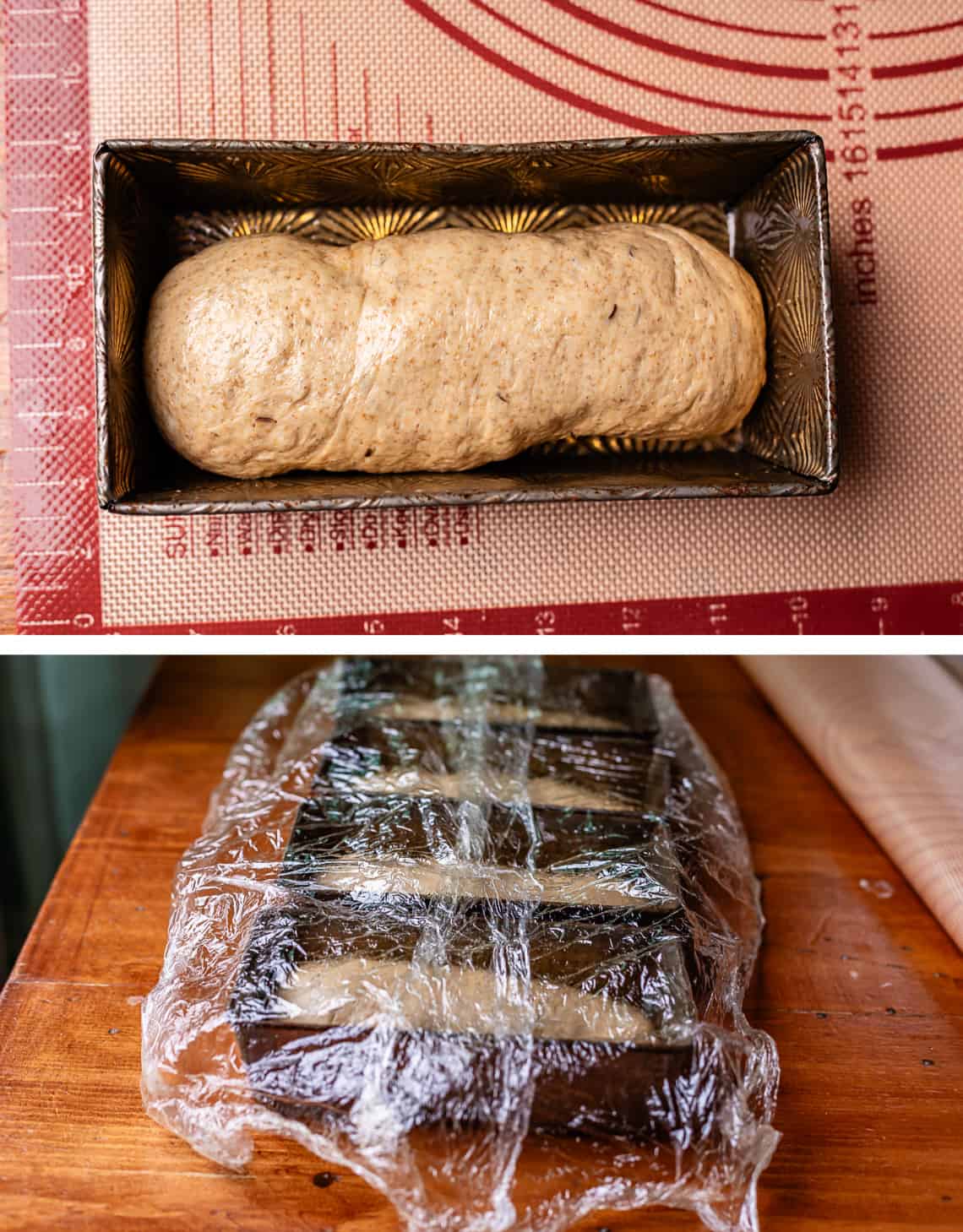
Here is dear Kris measuring her rye bread to make sure it has risen as least an inch over the top of the edge of the pan.
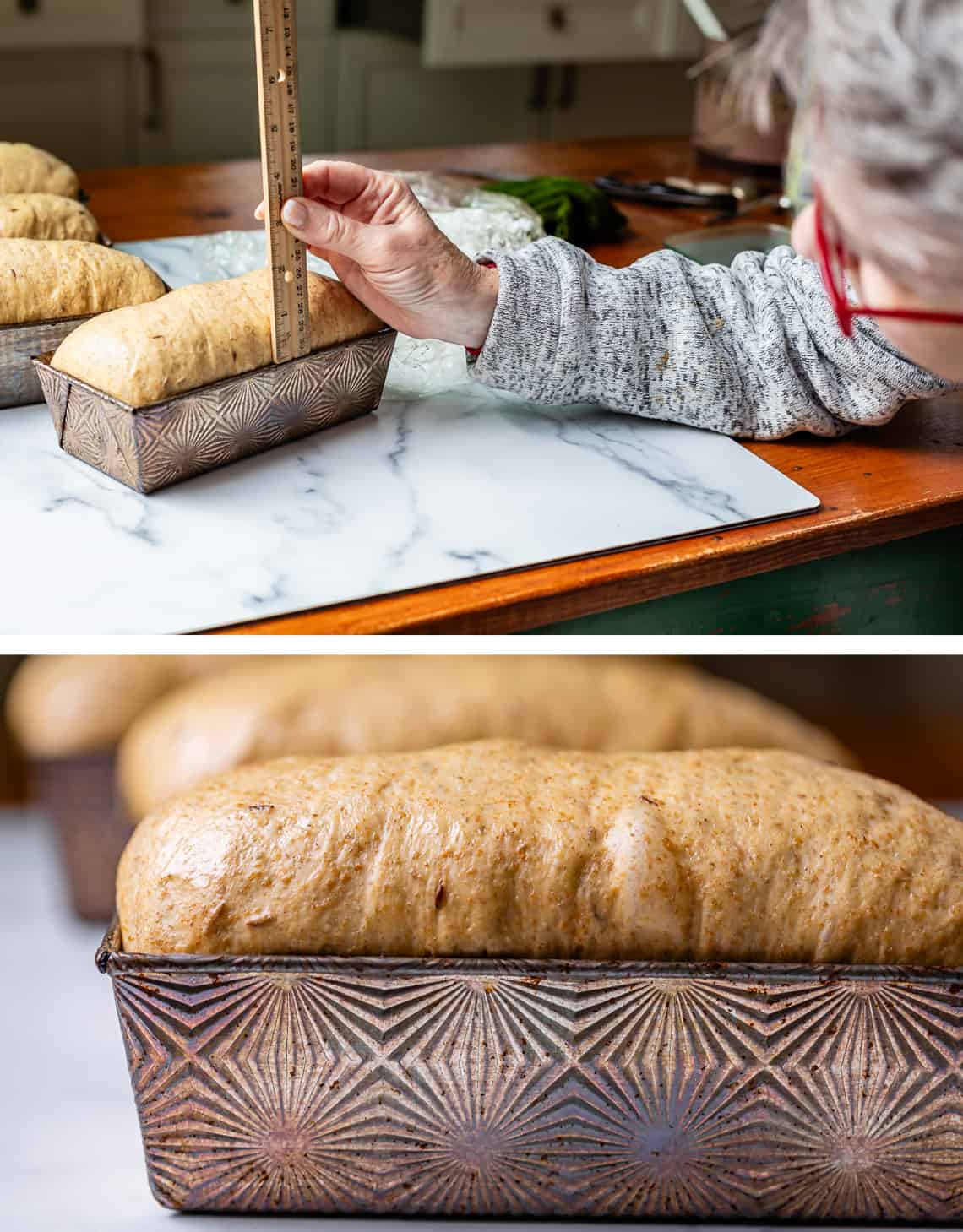
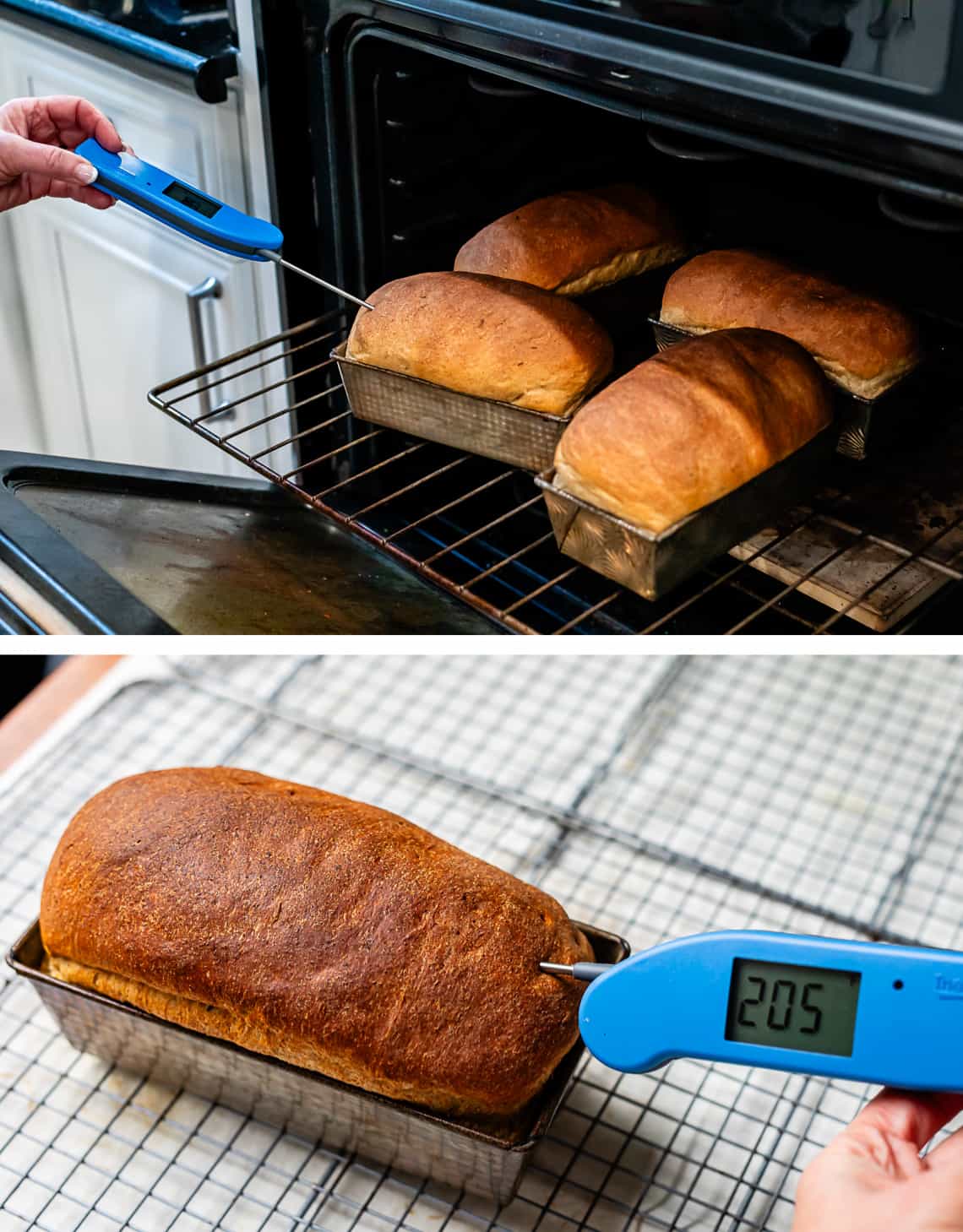
You can bake the bread all at once, the tiny pans fit on one rack. Do not take the bread out of the oven until it reaches 205! If you don’t have a thermometer, wait until the bread looks almost burned on top. Seriously. Rye flour is darker than white wheat flour. You do not want to under bake this bread.
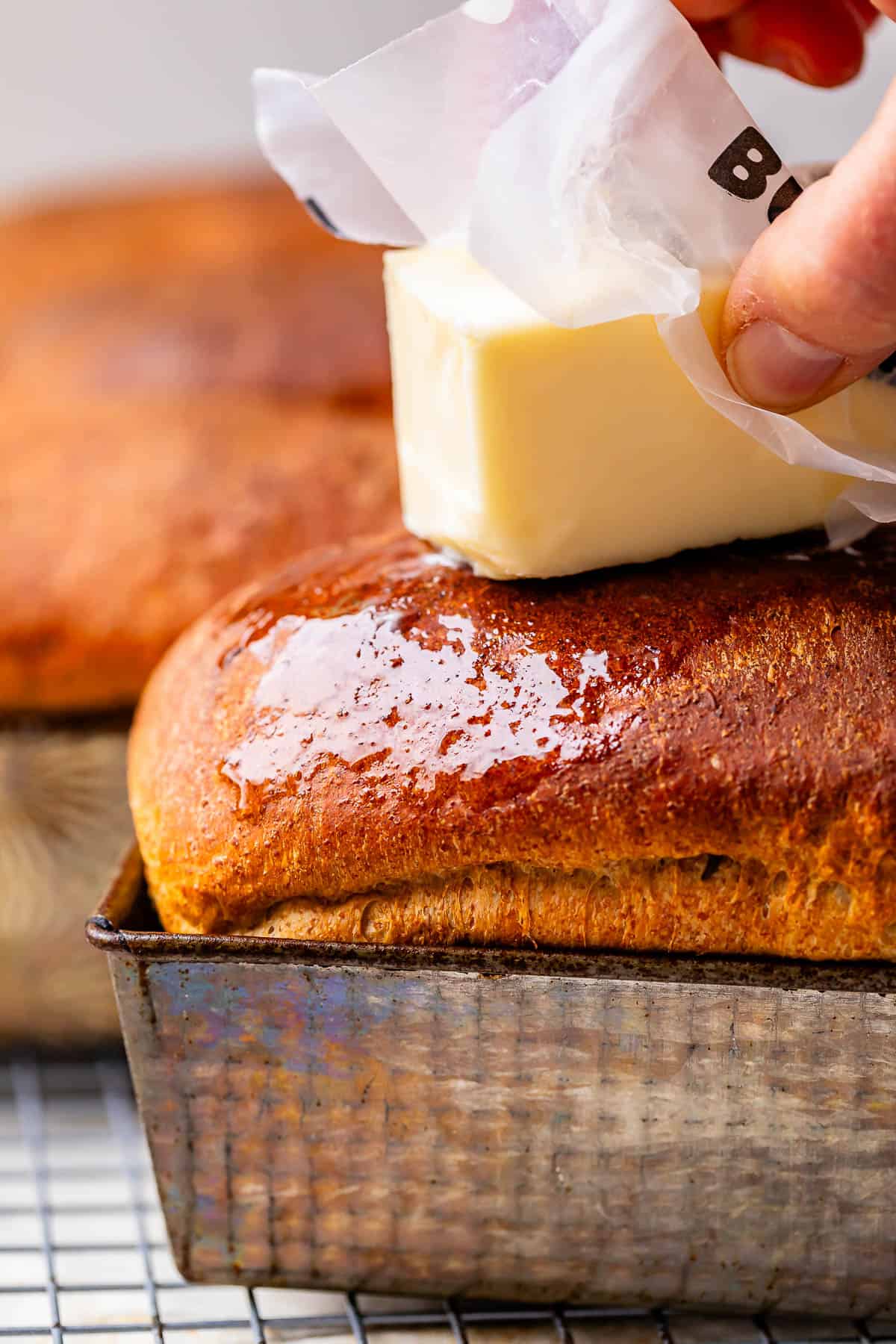
Rub a stick of butter on top of the bread until they are all coated with melted butter.
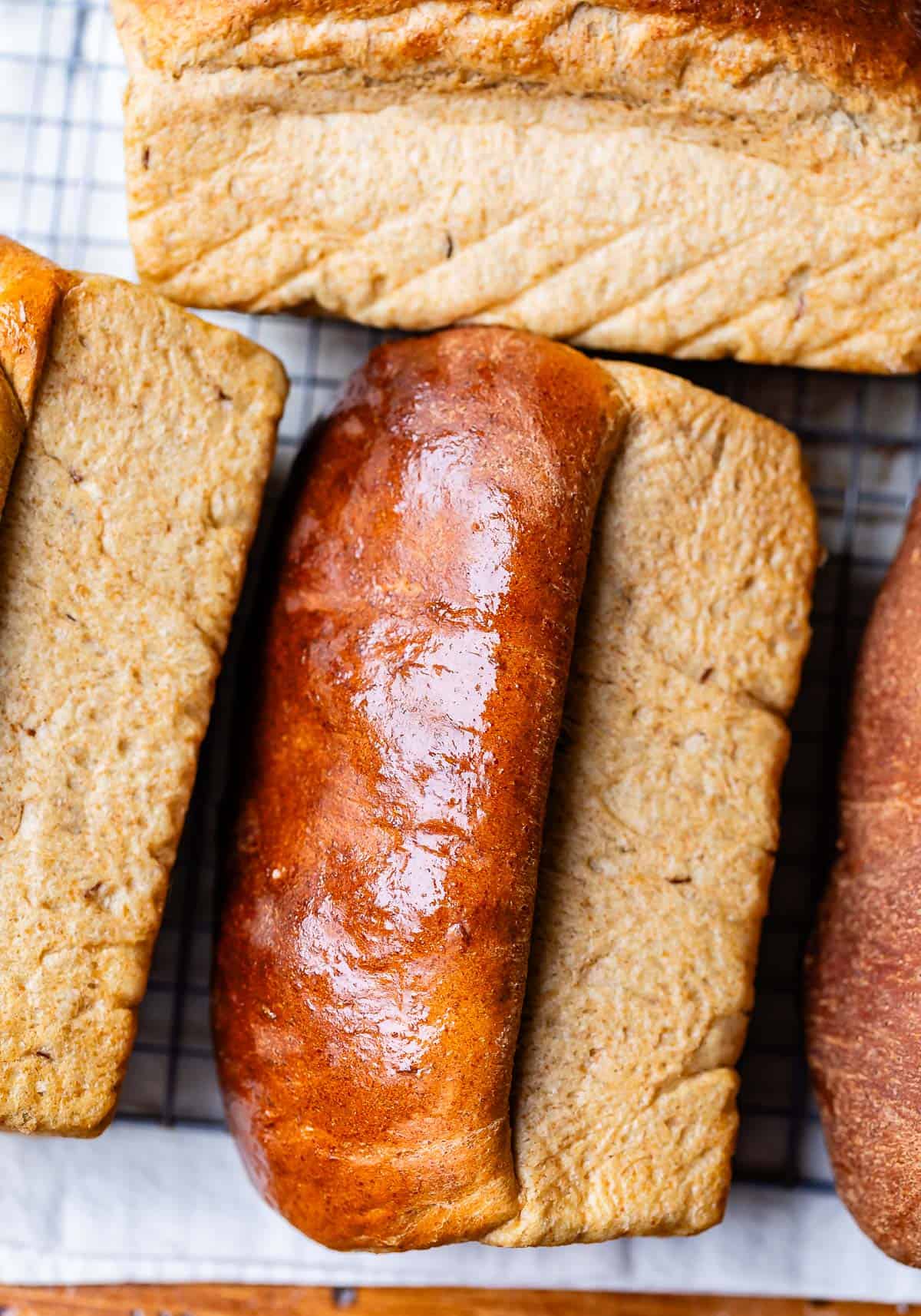
Then right away, turn the bread out onto a cooling rack, turned on it’s side so you don’t smoosh the bottom, and let cool. I know this is so hard! But Rye bread is very tender, and if you slice it while it’s hot it will crush the bread. And that is it! Time to devour with butter! Or see below for sandwich ideas!
Rye bread recipe tips
- For lightest, fluffiest bread that still gives that great rye flavor, choose light rye flour. If you are looking for the most nutrient dense or darkest rye bread, opt for whole grain rye flour (sometimes called pumpernickel flour).
- Don’t skip the regular wheat flour. Because rye is so low in gluten, it doesn’t rise well. There are other ways to overcome this, but the easiest method is to use a mix of rye and wheat flours, like in this recipe.
- Be aware that the dough’s consistency may be different than what you’re used to with wheat breads. It will be a bit more sticky and less elastic/pliable. It’s ok, that’s normal with rye.
- Rye bread, again because of its low gluten content, rises more slowly than wheat bread. That’s why we are doing 3 rises instead of 2! Don’t skip it.
What to do with homemade rye bread
- This is Eric’s Swedish great-grandmother’s recipe, and every year we eat it as a cocktail appetizer with Liver Pâté. Don’t knock it til you try it, it’s actually quite delicious.
- Toasted and served with butter and/or jam. Kris doesn’t put jam on Rye bread because it’s meant to be savory, but I actually love it.
- Make sandwiches! Even just a simple turkey and cheese sandwich will taste new and special with the different flavor and texture of rye bread compared to just wheat. Clearly our family needs to jump on the bandwagon with rye sandwiches, we just can’t seem to move past our toasted-with-butter habit! Here are some specific sandwich ideas I want to try out:
- A classic is a Reuben, of course!
- Oven roasted turkey and cheddar
- Roast beef and provolone
- Hot honey chicken and Havarti
- Pastrami and Swiss
- Corned Beef
- Egg Salad
- Grilled ham & cheese
- Any holiday leftovers combination, like turkey, ham, cranberry sauce, you name it
- Add toasted slices of the small loaves to a charcuterie board!
- This would make a great dipper for recipes like Extra Cheesy Spinach Artichoke Dip, Cheesy Buffalo Chicken Dip, or Bacon Blue Cheese Dip – YUM!
- Use it in place of wheat bread in this Savory Bread Pudding with Ham and Asparagus or Savory Parmesan French Toast with Hollandaise Sauce for a new kick
- Make homemade croutons (and then make Traditional Stuffing!)
- Savoy Cabbage Soup with Ham, Rye Bread, and Fontina from Brenda Gantt Recipes
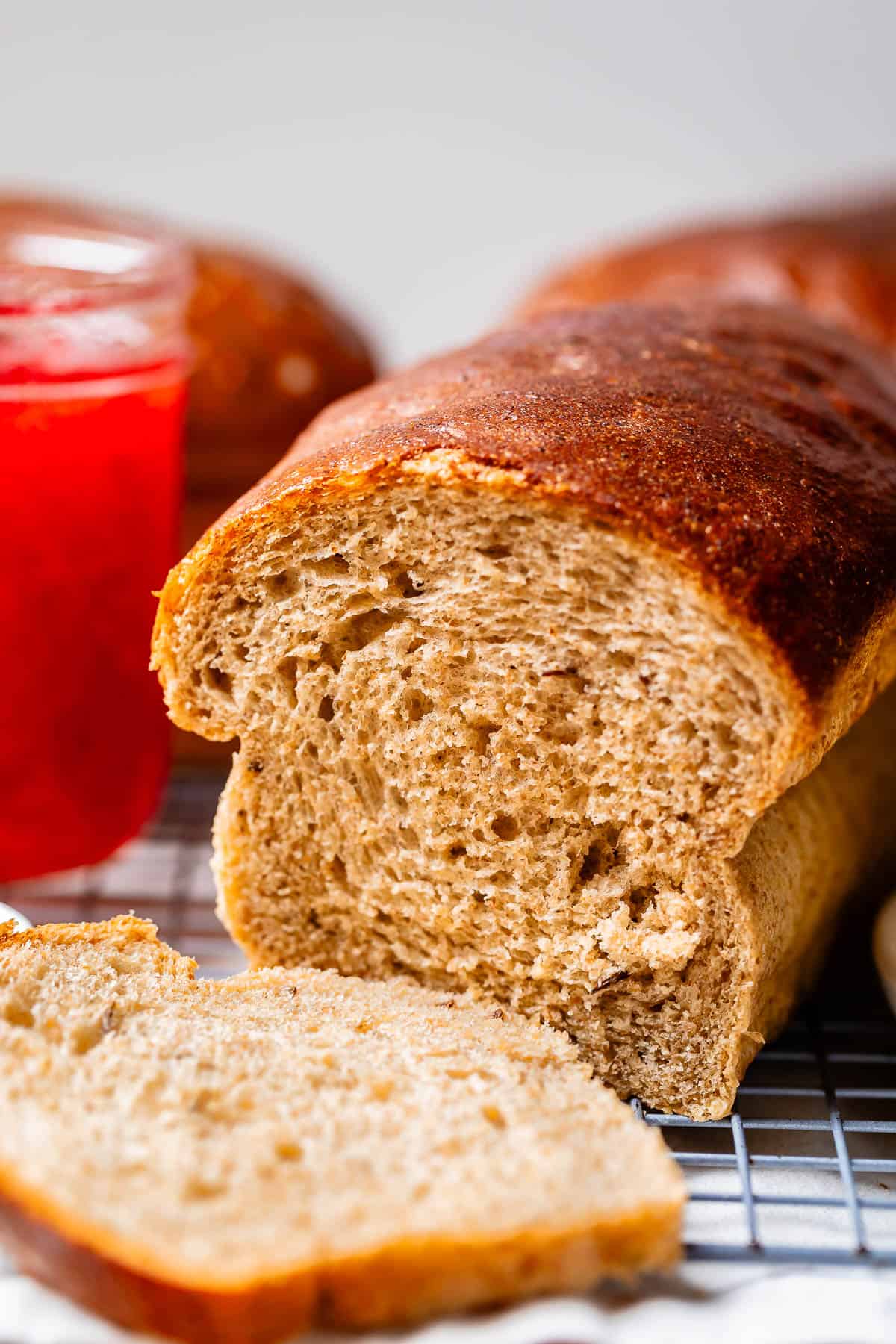
How to store leftover rye bread
The best way to store leftover rye bread is in a ziplock to keep it sealed and fresh. Do NOT refrigerate! It will dry out sooo fast. If it starts to dry out after a few days out on the counter, wrap the bread in a damp (NOT super wet) towel or paper towel, put it on a baking sheet, and put it into a preheated 200 degree oven for about 5 or 10 minutes. You can also try a similar method of wrapping the bread and putting it in the microwave for about 10 seconds at a time until it’s the way you like it.
Can you freeze rye bread?
Just like most other types of bread, this rye bread freezes beautifully. Make several loaves ahead of time and just pull one out each time you need it! We made so many batches of this bread for the photo shoot that my freezer is still completely full. And every Christmas when we go home to Montana, Kris has about a billion loaves tucked away in the freezer, ready for us to take out and fight over. Rye bread is our love language.
To freeze, make sure the bread is completely cool. If there’s a hint of warmth, the steam will be trapped in with the bread and could make it soggy. Next, wrap each loaf really well a few times in plastic wrap. Then you can either stick the loaves in freezer ziplock bags, or wrap well in aluminum foil. It will be good in the freezer for up to 3 months, but is best within 1-2 months so it doesn’t start to get dried out from all that cold air circulating.
To eat, thaw the bread at room temperature, still in its wrapping. If you prefer it warm, make sure you remove all plastic and wrap it in foil to keep moisture in. Put the loaf in a 350 degree oven for 5-10 minutes. The amount of time will depend on the size of your loaf, so just keep an eye on it!
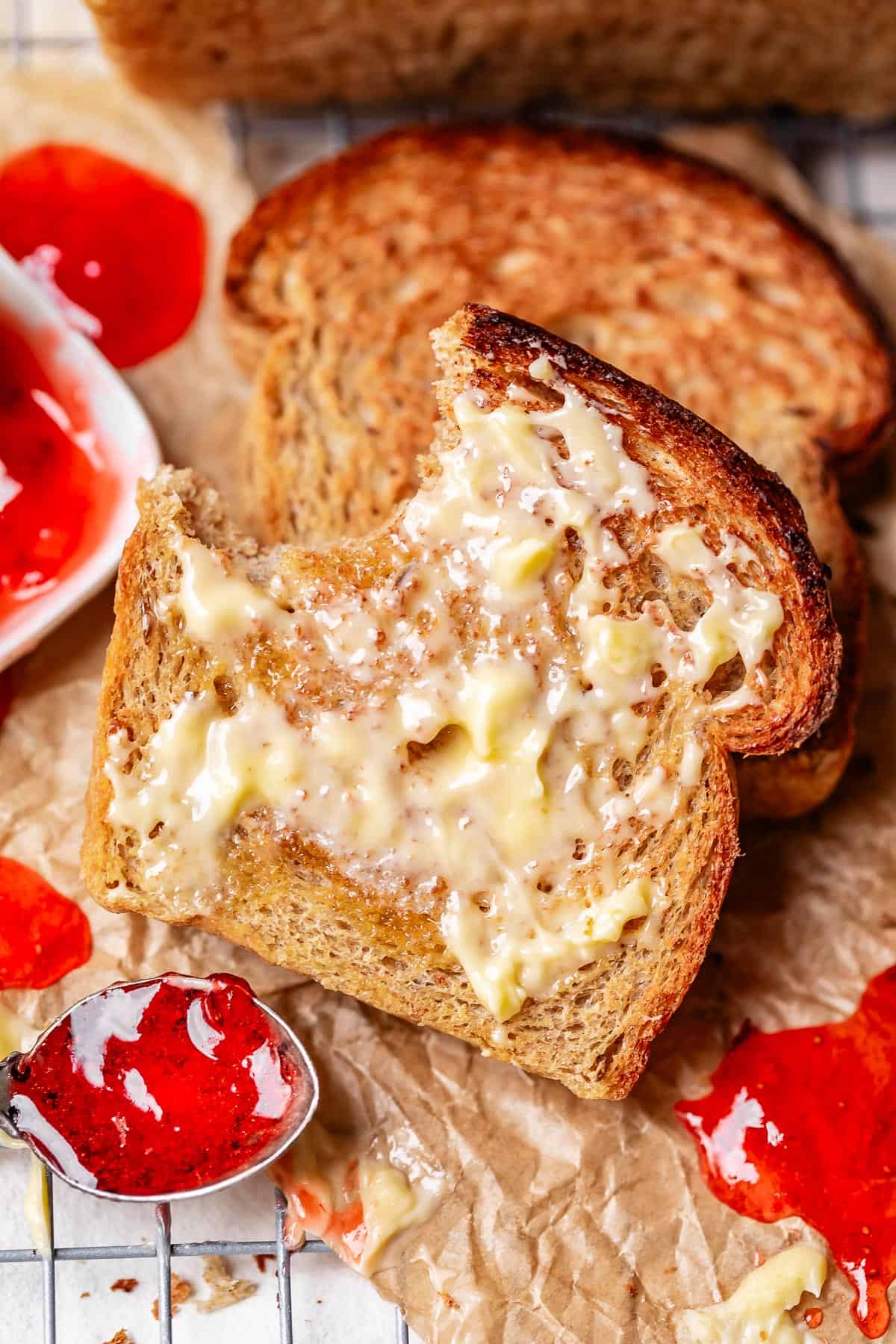
Frequently asked questions
Rye bread is a bread made from the rye grain, which is a distant cousin to wheat, with a different texture and taste. Rye is very low in gluten and doesn’t rise well, so most rye breads are either a combo of rye and wheat (like this recipe) or have a special technique to get a rise. In the United States especially, Caraway seeds are often used in the recipe and add an additional unique flavor.
Yes, rye bread is typically considered a very healthy bread. Rye has lots of nutrients, and many that are different (or in differing amounts) than wheat bread, so it’s great to add for variety. It also has a good amount of fiber and can be lower on the glycemic index, which means your blood sugars will increase more slowly than other breads. But, just like wheat bread, you get the most nutrients by using whole grain or sprouted rye (dark rye). We most often make this recipe using light rye flour so it is definitely healthy, but if you’re looking for the most nutritious bang for your buck, use dark rye flour which is a whole grain. We make it with either light or dark rye, both types work great, no changes to the recipe needed.
People google this question in reference to the heavy German/Jewish type of Rye bread. This recipe is different, and if you follow the instructions, your loaf will not be heavy.
Rye has a different chemical makeup than wheat, and you’ll notice these differences when baking. Rye has less gluten, which leads to a more compact, denser bread if you don’t pair with wheat flour. It also has a different carbohydrate structure than wheat; it has a starch called Pentosans that absorb more water, and then stay moist even after baking. It makes for a very “full” feeling, dense (but moist) bread. It helps fill you up faster and keeps you full longer (kind of similar to eating raw fruit vs dried fruit).
More delicious bread & roll recipes to try
There’s almost nothing better than smelling (and then eating) freshly baked homemade bread! Check out these amazing bread recipes!
- The Only White Bread Recipe You’ll Ever Need >> fast, easy, and tons of buttery flavor
- Quick and Easy French Bread Recipe >> this is a ONE HOUR recipe, guys!
- Best Irish Soda Bread >> I love how tender and flavorful this bread is, perfect with tea
- Garlic and Rosemary Skillet Bread >> the crust on this bread is unreal. Kind of like a deep dish pan pizza!
- Samoan Coconut Rolls >> if you like Hawaiian rolls, you’re going to love these, promise
- Big Fat Crescent Rolls, yeah >> the best ultra light and fluffy crescent rolls of your life, no joke
- Soft and Fluffy Parker House Roll Recipe >> cloud-like, with a swoon worthy swirl of butter in the center
- Artisan NO KNEAD crusty bread from Recipe Tin Eats
Facebook | Pinterest | Instagram
Grandma Prudy’s Rye Bread

Ingredients
- 1 scant tablespoon active dry yeast, about one (1/4 ounce) packet yeast
- 1 teaspoon sugar, to feed the yeast
- 1/4 cup warm water
- 1/2 cup granulated sugar
- 2 tablespoons molasses
- 2 tablespoons shortening, I like butter-flavored Crisco
- 2 teaspoons kosher salt, use less if using table salt
- 1 tablespoon caraway seed, optional
- 2 cups warm water
- 2 cups light or dark rye flour*, spooned and leveled
- 1/4 cup vital wheat gluten
- 3 cups all purpose flour, plus an extra 1/2 cup flour, about
- vegetable oil or olive oil, for greasing, plus more for rolling
- 1/4 cup butter, for rubbing on bread
Instructions
- Make the bread dough. In the bowl of a stand mixer, add 1 scant tablespoon active dry yeast. (Scant means not quite full). Or use 1 (.25 oz) packet of yeast.
- Add 1 teaspoon sugar to help the yeast grow, and 1/4 cup warm water. It should be about 105-110 degrees F, or about the temperature of nice bath water. Feel it with your wrist. If you wouldn't bathe a newborn baby in it, then it's too hot.
- Stir it together and wait 5 minutes to make sure your yeast is getting bubbly. If not, you have killed your yeast; dump it and start over. Better to start over now than after hours or non rising!
- Once you are sure the yeast is foaming, add 1/2 cup sugar, 2 tablespoons molasses, 2 tablespoons shortening, 2 teaspoons kosher salt, and 1 tablespoon caraway seeds.
- Add 2 cups of warm (but not too hot) water. Stir this mixture together with the dough hook, or with a wooden spoon.
- Add 2 cups rye flour, making sure to spoon the flour into the measuring cup and leveling the top.
- Add 1/4 cup vital wheat gluten flour along with the rye flour. Turn the mixer on to low speed, so that you don't poof flour everywhere.
- Add 3 cups of all purpose flour, 1 cup at a time. Turn the mixer on low, mixing in between each cup added. Don't add more than 3 cups of all purpose flour to begin with. This is the part that could make or break your bread, so look alive people. Rye bread dough is NOT THE SAME as regular bread dough. Adding too much flour will turn your bread into a sad, dry, flavorless waste of carbs.
- Knead the dough. Let your dough knead on medium-low speed for about 5 minutes.* The dough will be STICKY. As it kneads, the dough will start to clean the edges of the bowl, but will still be very sticky. Add up to another half cup of all purpose flour (for a total of 3 and 1/2 cups). Add the flour as it kneads, a tablespoon or two at a time, as necessary. Try not to add more than that, but use your best judgment, there are a lot of variables when it comes to bread making. Knead the dough for a full 7-10 minutes. The dough should start to clean the sides of the bowl, but not the bottom.You can of course knead it by hand if you don't have a mixer; knead for 10-12 minutes on an OILED surface, not floured.
- Grease the inside of a large bowl with 1 tablespoon vegetable oil.
- Rise the dough. Scrape the sticky dough into the greased bowl and shape into a ball. Turn it over to coat with oil. Cover with parchment paper or greased plastic wrap, and let rise in a warm place for 1 hour, or until doubled in size. I like to turn my oven on to 350 for about 45 seconds, then turn it off. You don't want a hot oven, just warm. If you can't touch the racks with your fingers, it's too hot (leave the oven door open until it's cooled a bit, if you overheated.)
- Once the dough has doubled in size, punch it down. Take it out of the bowl, reshape into a ball, and grease the bowl with more oil. Return the dough, turn to coat with oil, and cover. Reheat the oven for another minute until it is warm again, and let rise a second time for about 1 hour, until doubled in size.
- Punch down the dough a second time. Prepare a work surface with a tablespoon or so of oil. I like to lay a silpat or two on my counter, then grease them with oil. You don't want to roll this bread out on flour, it will get too stiff!
- Prepare four (7×4) inch pans** with nonstick spray. Be generous! You don't want this bread to stick. (You can also use two 9×5 or 8×4 inch pans.)
- Shape the loaves. Divide the dough into 4 pieces. Use your hands to pat each piece of dough into a square that it about the length of your pan, 7 inches. Use your fingers to fold the top 7-inch-edge of the dough down about an inch, pat it in with your fingers, then roll again, then keep going until it's in a cute little roll. Pinch the edges into itself. Tuck the ends underneath. Place each roll seam side down in the pan. (If you are using a 9×5 inch pan, split the dough in half and follow the same instructions.)
- Cover all the pans with parchment paper or greased plastic wrap and let rise in a warm place (I do this in the lightly warmed oven as described before) until doubled in size, about 45 minutes. The dough needs to crown the pan and rise over the edges (at least an inch or so) before it goes in the oven. Wait longer if you need to!
- Bake the bread. Preheat the oven to 375 degrees F. (Take the pans out of the oven about 30 minutes into this last rise, if you are keeping them warm in there! Don't preheat your oven with the bread inside!)
- Bake the bread at 375 for about 30-35 minutes for 7×4 inch pans. For 9×5 inch pans, bake for about 40-45 minutes. Read on:
- I highly recommend using an instant read thermometer to test the bread for doneness. Kris has made this recipe a thousand times and still uses a thermometer every time. A thermometer inserted into the center of the bread should read 205 degrees F before you take it out. For a 9×5 inch pan, wait until the bread reaches 208-210 degrees F.
- If you don't have a thermometer, wait until the loaves are well browned on top. They might even look a little burned; remember, rye flour is darker than wheat flour. It's better to over bake than under bake. (You can add more butter to dry bread, but you throw away doughy-in-the-middle bread.)
- Place the hot pans of bread on wire racks and let cool for about 1-2 minutes. During this time, rub a stick of butter all over the tops of the bread until they are covered with melted butter.
- Immediately (and carefully, using hot pads) turn the bread loaves onto the cooling racks. The bread should come right out, but if it doesn't, loosen with a knife. Let the bread cool out of the pan on the racks, turned on their sides. Kris cools them on their sides because this bread is so tender and soft (and top heavy) that if you keep them upright it tends to smoosh the bottom half of the bread.
- I know this is killer, but you HAVE to wait for rye bread to cool a decent amount before slicing in, about 30-60 minutes. It is so soft and tender that you will crush the bread if you slice while too warm. I often don't follow my own advice well enough on this.
- Use your sharpest serrated knife to slice the bread, using sawing motions, not pushing down. Cut the bread on it's side if you suck at following instructions and it's still slightly warm.
- Slather with copious amounts of butter and eat immediately. Or pop in the toaster until almost burned, add an obscene amount of butter, and enjoy the shattery crisp flavor. Add jam if you're like me. For a retro twist, spread with Liver Pate (we do this every Christmas Eve.)
- How to store: Once the bread is completely cool, store in a big ziplock bag on the counter for up to 3 days. It's best to slice as you go, so it doesn't dry out. If you are not planning to eat it right away, it's always best to store it in the freezer. Bread freezes beautifully.
- How to freeze: Store the bread in a large ziplock bag, press out as much air as you can, and freeze for up to 3 months. Let thaw on the counter with the bag sealed for an hour or so. Or if you need it now, you can defrost it in the microwave on the defrost setting or on low power. Keep an eye on it and don't let the bread get too hot, it will start to cook it (and get tough). It's best to slice partially-frozen bread and pop slices right in the toaster to finish thawing.
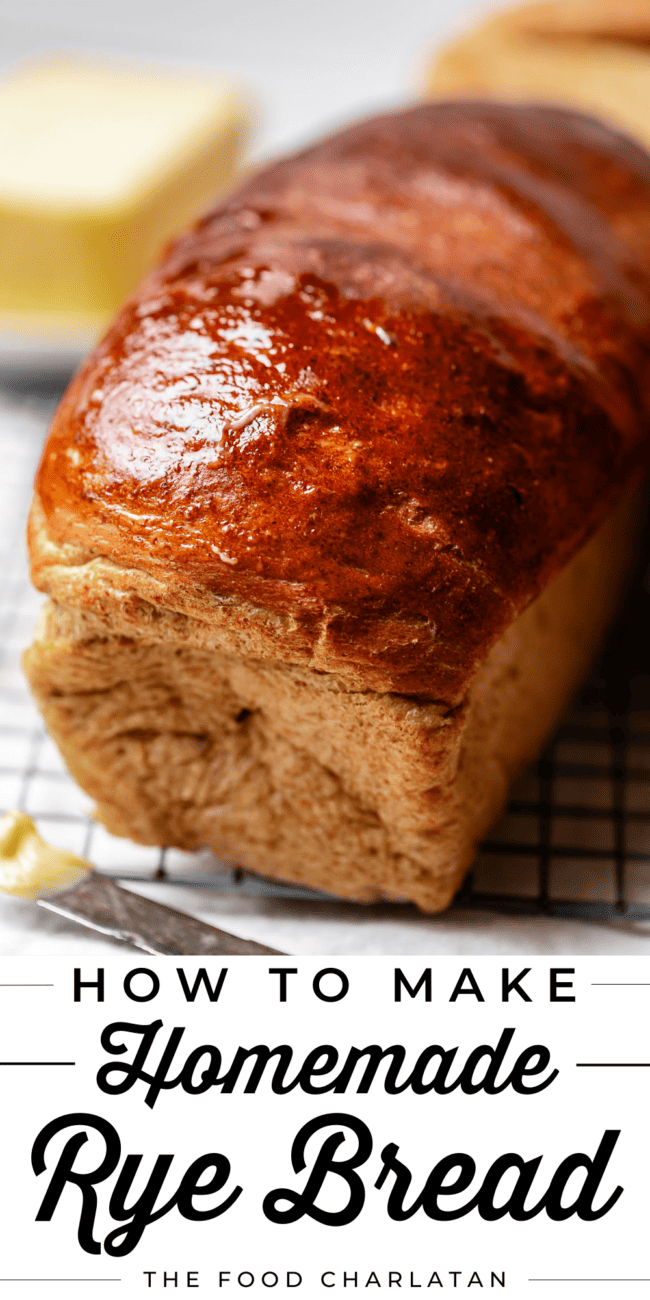
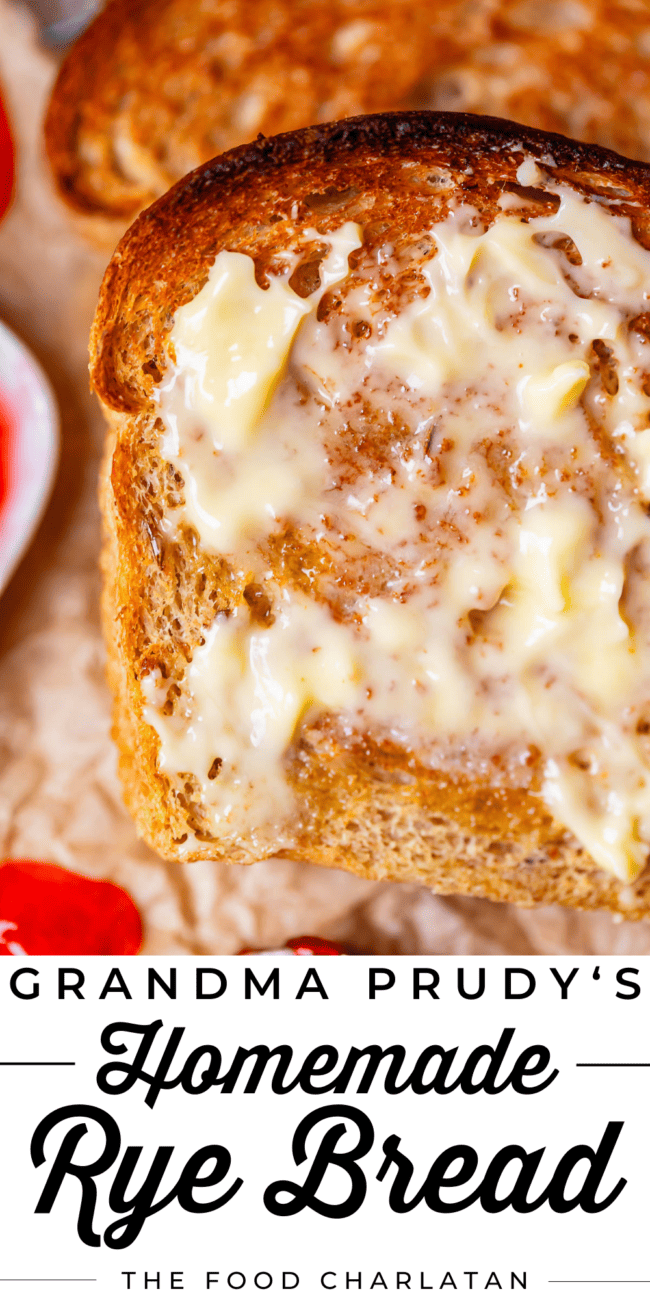
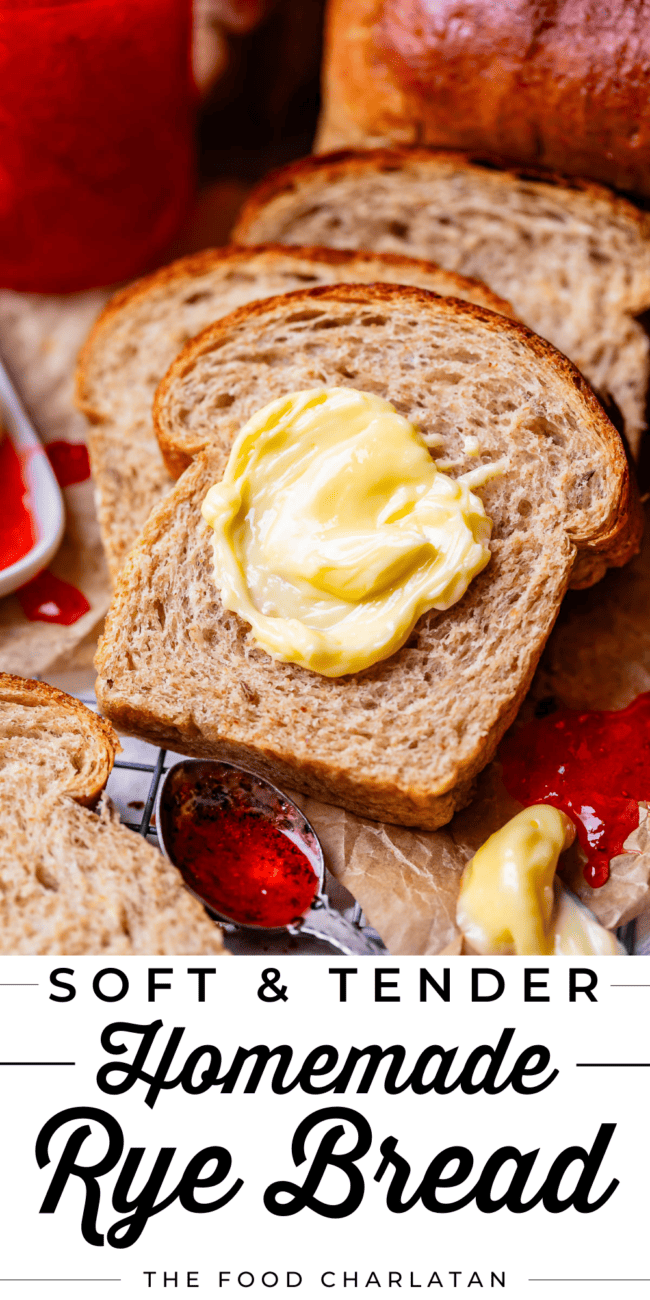

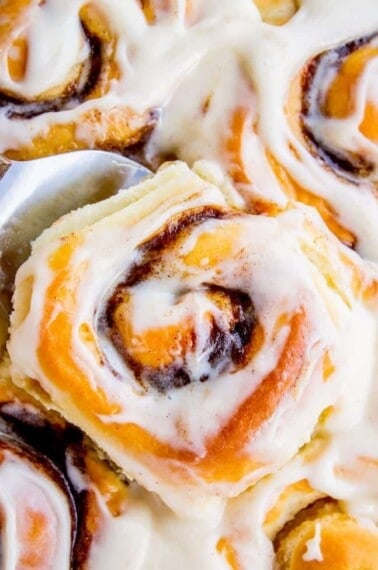
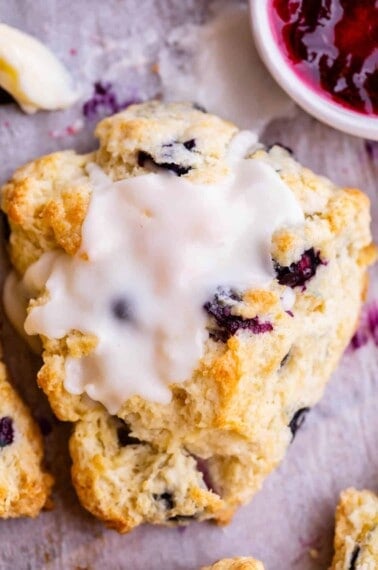
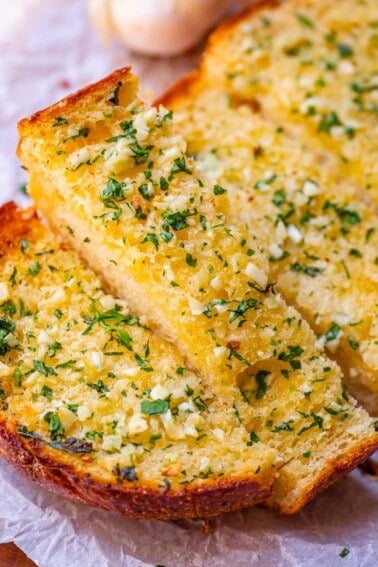
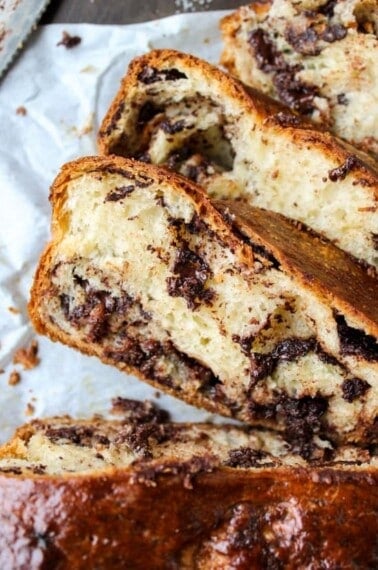









So finally someone who understands what rye bread SHOULD be like! I have a wheat intolerance but can handle spelt without issue – can I use that? Also, how s instant yeast ok? And thirdly, I live with my mom who does not have am oven as she hates them. We gave gas burners and an airfryer. Which I use for most things. Is this recipe good for an airfryer?
Hi Tanith! We’ve never tested this recipe with spelt or in an air fryer. If you try either, let us know how it turns out! Using instant yeast is just fine.
Thank you Sarah. I need to shrink the dough amount though, heck of a lot there 🤭 I’m good with ratios though so it shouldn’t be too difficult. I’m looking forward to this – just tried an airfryer recipe and the dude was mental! 125mls of water to TWO cups of flour? And then knead it till it becomes elastic? Not well at all. And if course only one rise. It was fine if you want to make a mini loaf, 4 by 7, and 1 inch high! And brick like in consistency. Grrrrrrrr! Will try yours in the morning and let you know if I got it right or not 🤭
What a wonderful post. I love the story and the bread tips from your mom!
Great recipe !! gonna try in bread machine for the dough ya know what’s also Great YOU A realist. what you see is what you get ! I love the world you live in ! ” PeaceBeWithYou “
Also, I have Nana’s larger Kitchenaid mixer and can fit the big batch in it. I do a half batch in my bread machine. And as for caraway seed.. the more the merrier. I’m really am glad you’ve posted it… my recipe book won’t last much longer.
Karen,
I’m so glad you finally posted this.. now EVERYONE will know the Johnson family secret recipes.
I’ve never seen or heard of the bread shaping extremes my sister Kris claims to do. She’s been holding back with that instruction. A ruler? Are you sure that wasn’t for the camera?
Also, this year I made the first batch. Don’t forget that.
Love you all!
Ahahahah!! Of COURSE Kris doesn’t use a ruler. I made her bust it out for the photo so that readers would know that I’M SERIOUS THAT BREAD BETTER CROWN THE PAN 😂😂😂 thanks Linda I love you!!
So glad you’ve posted this! Excellent instructions. I hope people love it as much as our family. Gramma would be so proud, Karen. ❤️
They serve rye bread in heaven, right? Prudy and I will have to enjoy a slice together someday 😂💕 Thank you for all your help getting this post done!
My husbands family makes this Swedish rye bread as well! I’ve never seen anyone else talk about it. It’s so good and way different than regular Rye bread!
Aha YAY! Swedish marry-ins, unite! I’m so glad to hear from you Brooke, this recipe really is so different. Thanks for taking the time to chime in! Rye bread forever!